Advanced Wound Care
A holistic approach to healing.


A holistic approach to healing.

Ensure your facility has the tools and expertise to tackle chronic wounds with the broadest range of advanced wound care products in the industry and a comprehensive package of educational resources.
Together we help you implement best practices to positively affect the quality and efficiency of care and optimize patient outcomes.
Our latest innovations
PluroGel® concentrated surfactant (Micelle Matrix™) technology
IoPlex® with I-Plexomer™ technology
—the world’s only controlled release iodine foam dressing
Optifoam® Gentle Ag+ Post-Op with Smart Stretch™ technology
Opticell® with Chytoform technology
Puracol® Collagen Dressings
—the most robust collagen portfolio on the market
p. 7
p. 13
p. 23
p. 32
p. 40
Medline’s clinical and educational resources provide you with support you need to raise the standard of care.
• Skin Health Product Specialists
Help you optimally leverage the support Medline offers as you strive to enhance quality of care.
• Educational Packaging
Ensure that caregivers have complete step-bystep instructions for use at their fingertips.
• Medline University
Expand staff expertise with unlimited access to over 200 free continuing education courses for healthcare professionals. Visit: MedlineUniversity.com
• Skin Health Hotline
Free access to a board-certified wound care nurse from 8am–5pm Central Standard Time Monday–Friday. 1-888-701-SKIN (7546).
• The NE1 Wound Assessment Tool
Helps increase accuracy, consistency and transparency in wound assessment.
• Skin Health Solutions
Minimize care variation across your facility with a customized approach to standardizing product, practice and education.
• Wound and Skin Care Guidelines
Clinical support to help you determine and communicate your treatment guidelines.
• Online Product Application Videos

Complete library of instructional application videos helps train new staff on proper product application. Visit: www.medline.com/awcvideos
• Advanced Wound and Skin Care Pocket Reference Guide
This compact booklet contains a wealth of clinical and product information for use as a reference tool for caregivers.
• Skin Health Digital Platform
Mobile app makes it easier for caregivers to do the right thing. Encourage staff to download our Skin Health app with QR code.

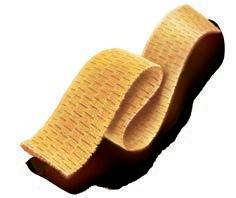

You face diverse and complex challenges. That’s why we offer a wide variety of products and programs that help clinicians deliver world-class care tailored to any given clinical context.
Throughout this catalog, you’ll find evidence-based products*, information and resources, all organized around the DIMES system of wound bed preparation and treatment.
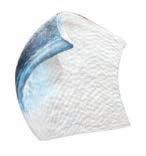
The first step in wound healing is the removal of necrotic tissue that can impede the growth and proliferation of healthy granulating tissue.
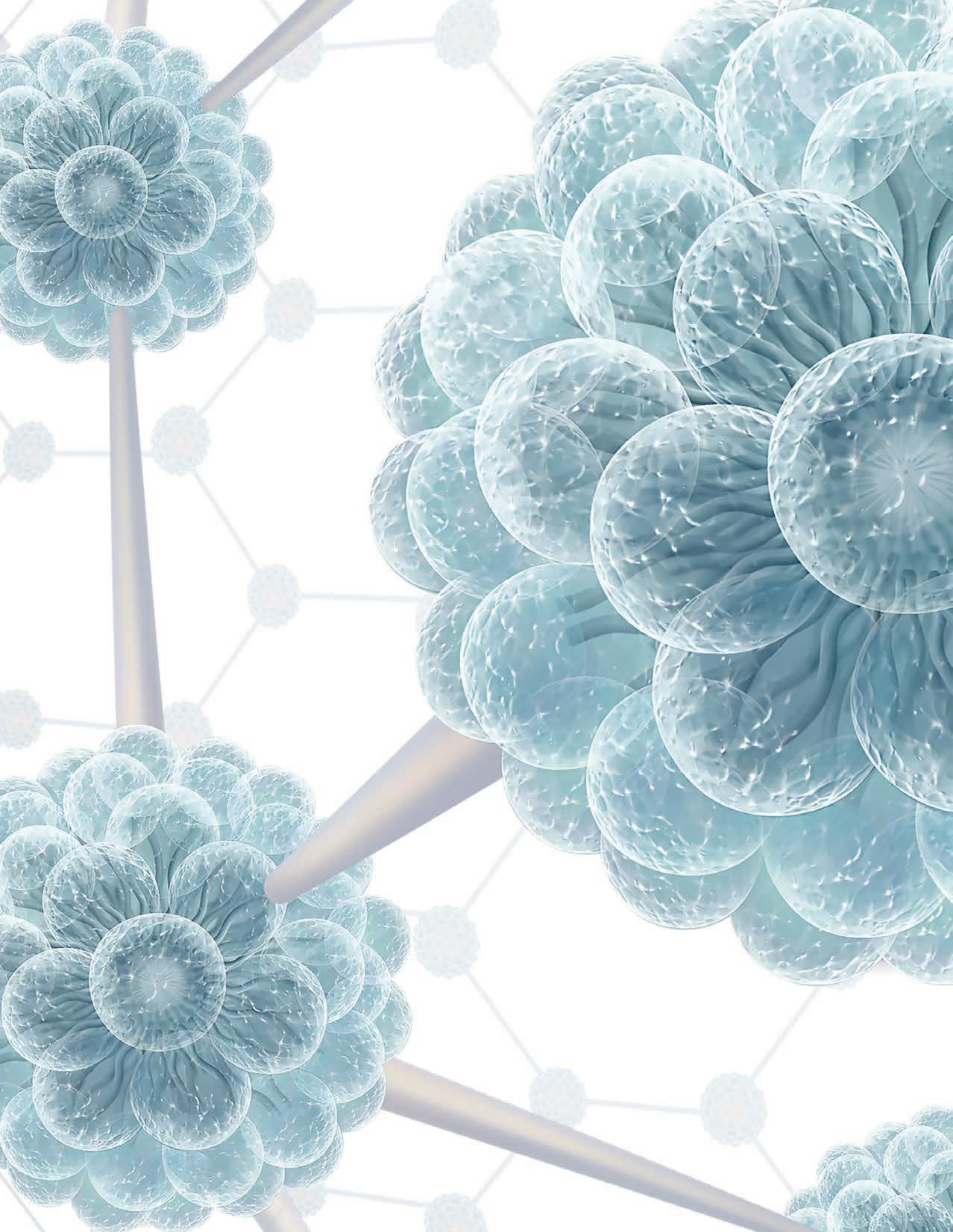
PluroGel is a unique burn and wound dressing utilizing Micelle Matrix Technology™, a concentrated, cell-friendly surfactant that aids in maintaining an optimal moist wound healing environment. PluroGel helps to protect the wound and soften wound debris.
100% water soluble— PluroGel softens wound debris and allows it to easily rinse off at dressing change, creating a positive dressing change experience. Gentle, non-irritating formula—Allows for a gentle patient experience.
Better adherence to wounds— PluroGel maintains its consistency, enabling it to remain on the wound bed for better protection.
PluroGel’s unique micelle gel matrix maintains moisture in the wound and helps control fluid loss, helping to protect the wound and to soften wound debris.
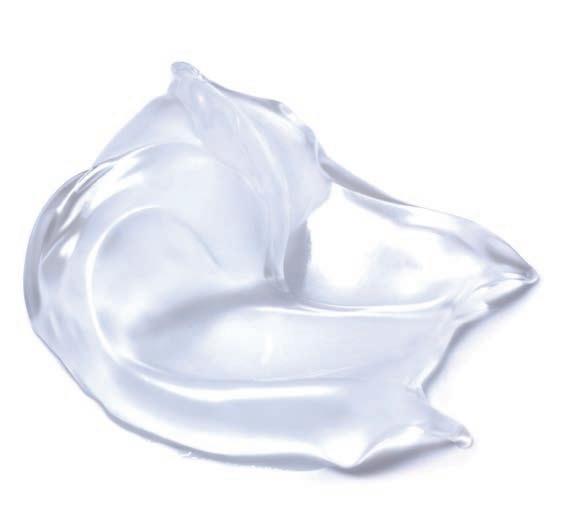
PluroGel’s micelle matrix contains surfactant micelles. A micelle's hydrophilic surface bonds with water, facilitating movement in the wound environment. Exudate and wound debris is absorbed within the hydrophobic core, allowing for easy removal at dressing change.
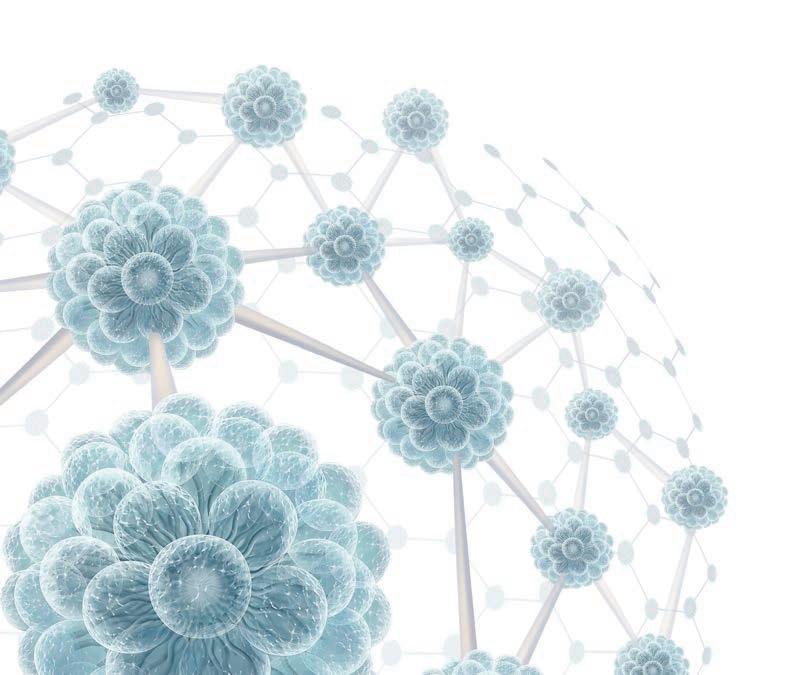
Hydrophobic Components in center (Illustrated in gray)
Hydrophilic Components on surface (Illustrated in blue)
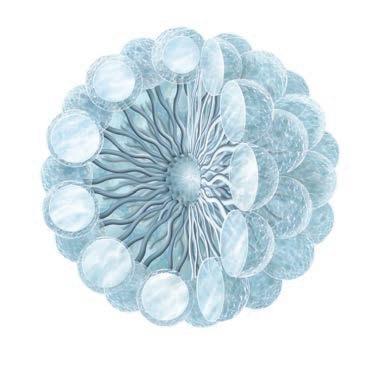
Based on in vitro testing
54 year old patient Thrombophilia fell during the night and developed a large hematoma on left anterior shin. 2
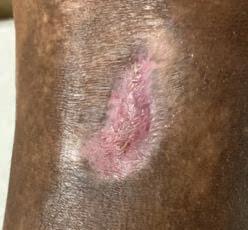

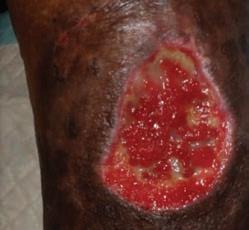
Application of PluroGel Burn and Wound Dressing daily resulted in rapid response—a dramatic reduction in wound size and resolution of undermining. Wound healed in 8 weeks.
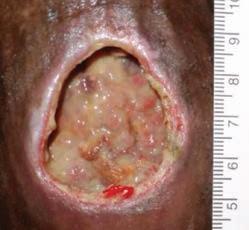
• 100% water-soluble, bio-compatible, cell-friendly
• Softer wound debris rinses off more easily at dressing change
• Helps to create and maintain a moist microenvironment
• Remains on the wound bed for better protection
Recommended Uses
• Light to moderately draining wounds
Recommended
Secondary Dressings
• Optifoam® Gentle
• Optifoam Thin (dry wounds)
• Petrolatum based dressings (burns)
Indications
Over-the-counter:
• Minor cuts, minor abrasions, minor lacerations and minor burns
Under the supervision of a healthcare provider:
• Partial and full-thickness wounds
• First and second degree burns
To order by each, add an “H” at the end of the item number.
• PluroGel should be changed daily or as needed or directed by a physician to keep wound moist
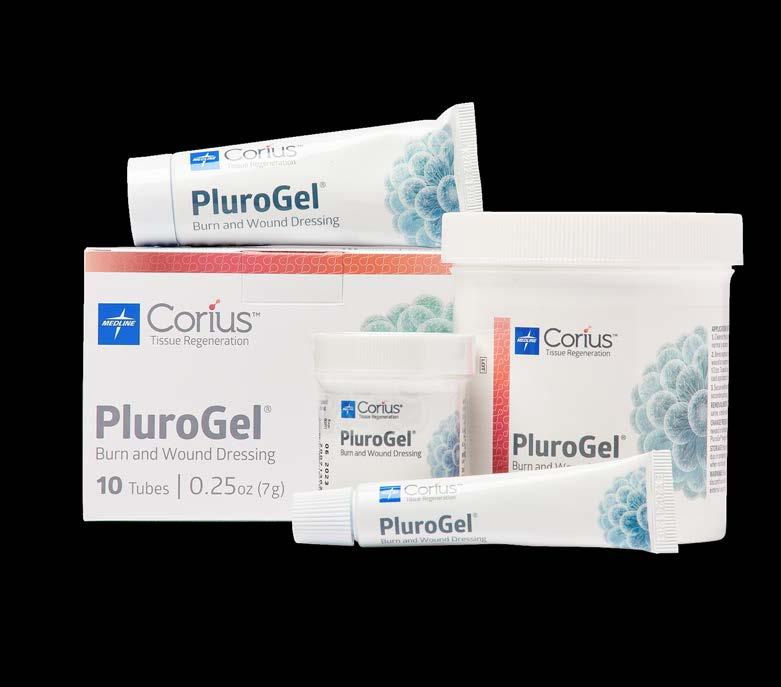
• PluroGel can remain in the wound bed for up to 3 days
• Be sure to apply 5 mm thick if changing every 3 days
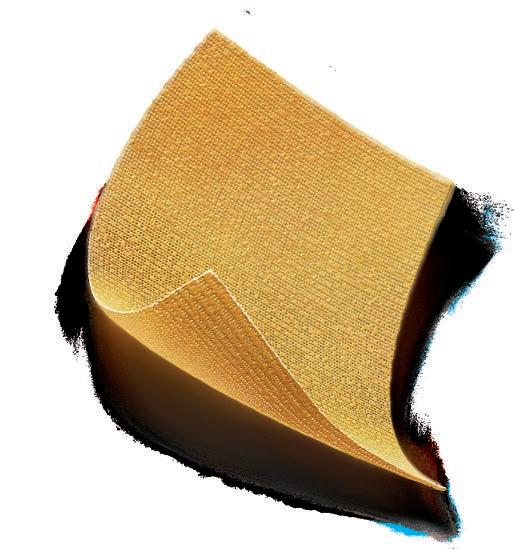
TheraHoney products contain 100% sterile, medical-grade Manuka honey with no fillers or additives. Honey is well-tolerated by patients and helps promote healing in hard-to-treat wounds. Its high sugar content and low water activity result in osmotic pressure that promotes autolytic debridement of necrotic tissue and creates a moist wound healing environment.
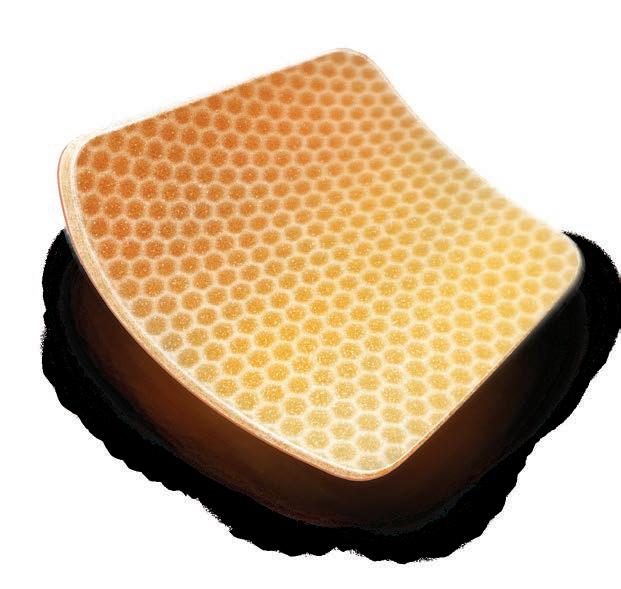
Honey’s high sugar levels (87%) help clear away necrotic tissue, maintain a moist wound environment for healing and reduce wound odor.
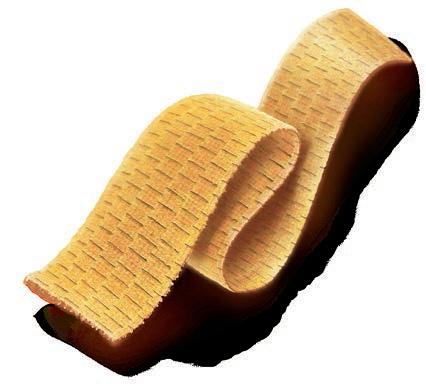
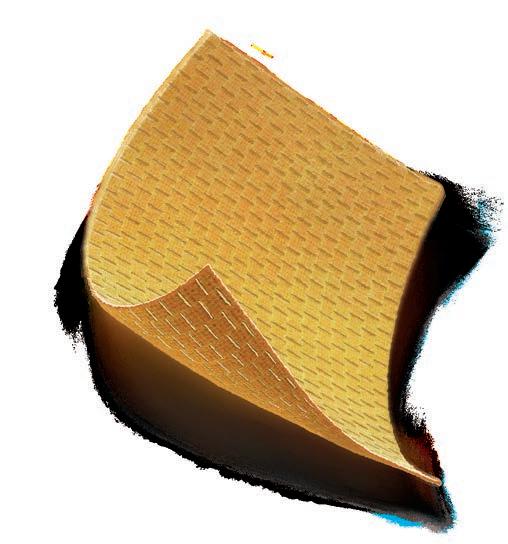
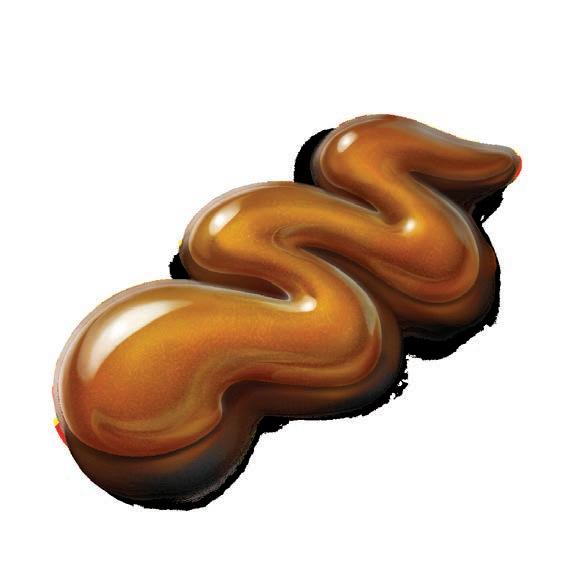
High wound pH can be a barrier to healing. The use of Manuka honey dressings is associated with a statistically significant decrease in wound pH.
Wounds can smell for a variety of reasons. The use of honey is known to reduce odors stemming from the wound bed.
• Made of 100% medicalgrade honey (Leptospermum scoparium)3
• A moist wound environment allows autolytic debridement of necrotic tissue.4–6
• Helps rapidly reduce odor4,6
• Should be paired with an absorbent dressing7
• Compatible with silver dressings and wound cleanser surfactants8
Recommended Uses
• All drainage levels
• As a primary dressing
Recommended
Secondary Dressings
• Optifoam® Gentle
• OptiLock®
• Qwick™
Indications
Over-the-counter:
• Minor abrasions, minor lacerations, and minor cuts
• Minor scalds and minor burns
Under the supervision of a healthcare provider:
• Leg ulcers
• Pressure injuries
• First- and second-degree burns
• Diabetic foot ulcers
• Surgical and trauma wounds
Change Frequency
• Therahoney change frequency may depend on amount of drainage but may be left in place for up to 7 days
Contraindications
• Third-degree burns
• Individuals with a known sensitivity to honey or bee venom
TheraHoney draws fluid from the wound bed, encouraging autolytic debridement. Use Qwick Superabsorbent Wound Dressings in conjunction with TheraHoney for optimal absorbency. See page 35 for more info.
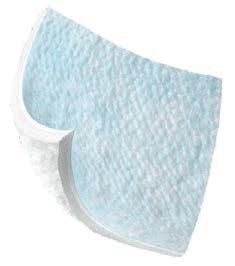
To order by each, add an “H” at the end of the item number.
* The current physician fee schedule does not price for HCPC
TheraHoney HD sheet has 2x more honey than the TheraHoney sheet
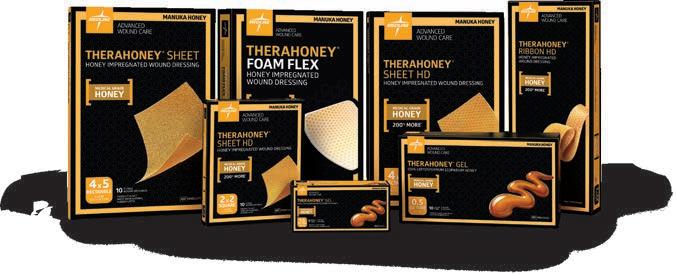
Potentially harmful microorganisms contaminate nearly all wounds. Actively managing bioburden and infection risk is key to effective wound management.
Antimicrobial silver and iodine dressings manage bioburden to help prevent delayed healing due to infection.
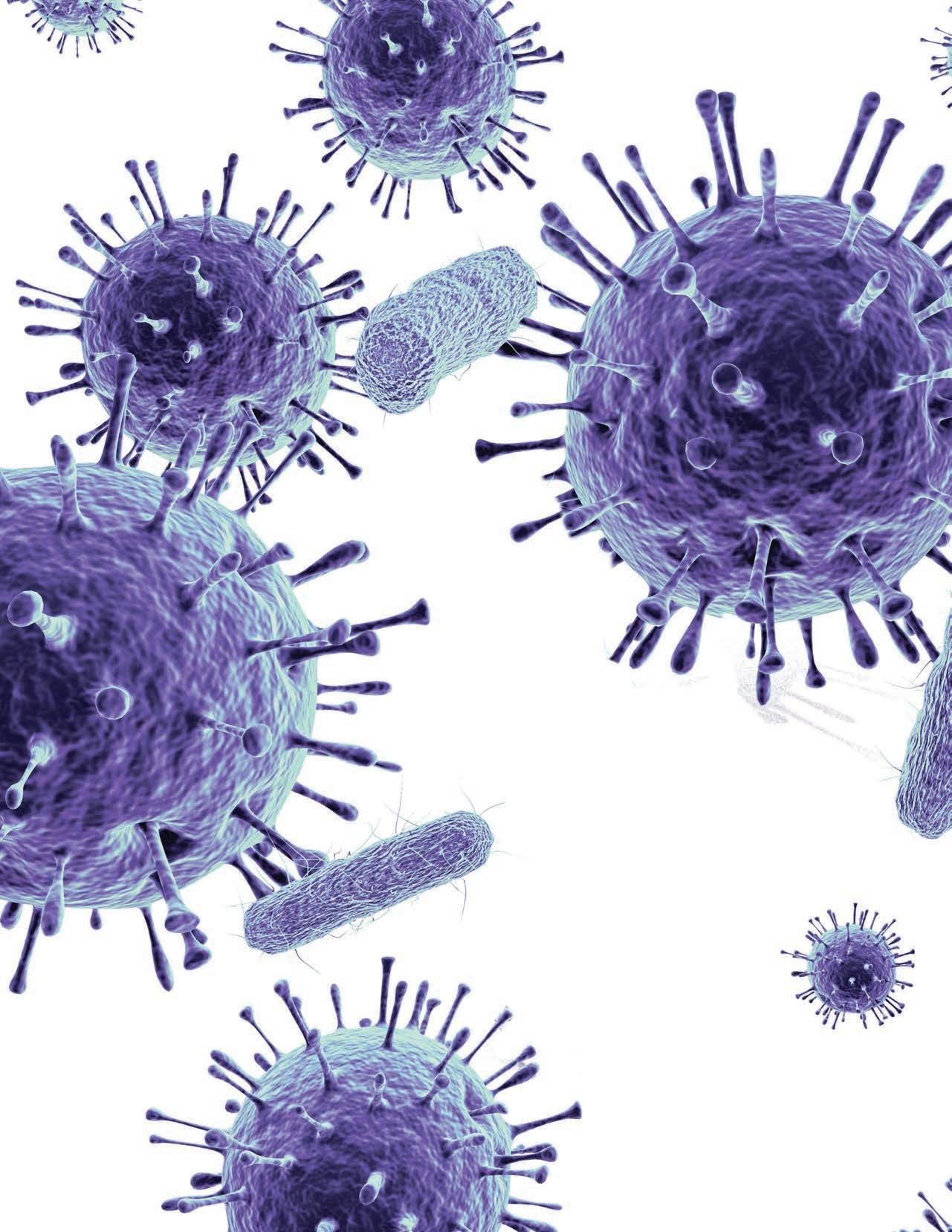

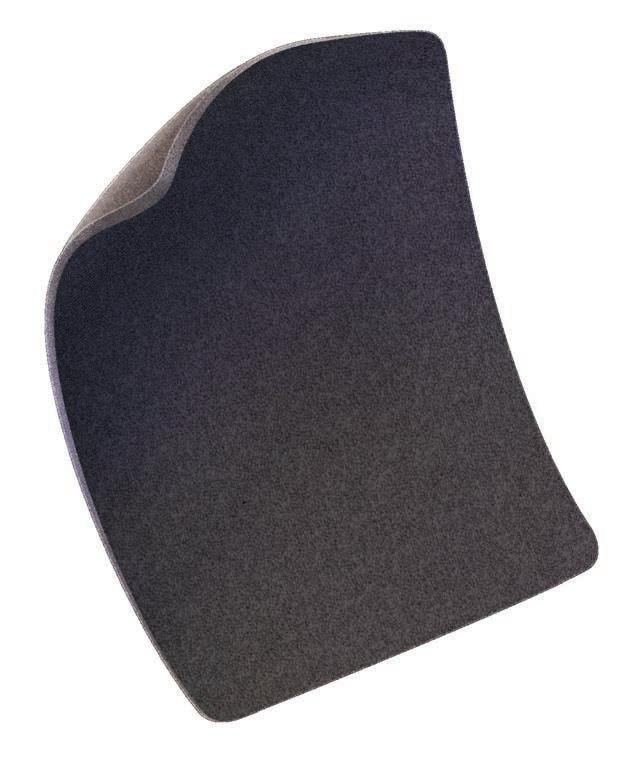
Let iodine take biofilm to task
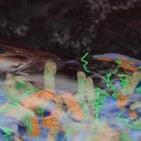
More than 90% of chronic wounds contain biofilm, which stalls wound healing and contributes to chronicity. Biofilm is very difficult to remove because it firmly adheres to surrounding tissue and it is highly tolerant to antibiotics. Not even debridement adequately manages biofilm.9
Enter iodine. Long known as a powerful antiseptic, numerous in-vitro studies demonstrate its superiority to other antibacterial agents–including silver–at controlling biofilm.10,11,12,13
IoPlex with I-Plexomer™ technology is the world’s only controlled release iodine foam dressing. A proprietary controlled-release system allows for regulated and sustained infection management through the slow release of iodine within the wound dressing.
Biofilms are bacterial structures physically attached to a surface and characterized by significant tolerance to antibiotics and biocides. Their existence is argued as the single most important cause of delayed wound healing.14
Iodine has been used in wound care since the American Civil War. Although quite cytotoxic in its native state, the iodine of today is bonded to a carrier molecule for a gentler release that maintains efficacy against microorganisms.15
PVA foam has exceptional capillary action to remove excess wound exudate.

IoPlex killed more P. aeruginosa biofilm than Hydrofera Blue at 24 hours in vitro16 Dead biofilm Living biofilm
Control: Basic Foam Dressing
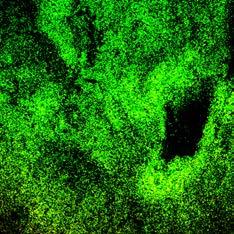

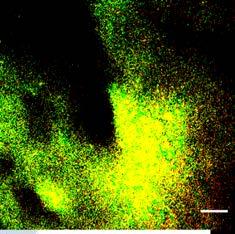
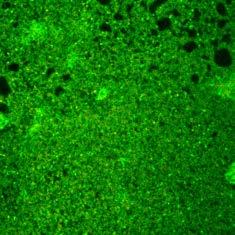
In-vitro testing showed that IoPlex had a greater than 4 log reduction against S. aureus and P. aeruginosa biofilm strains.16 Clinical significance of these findings have not been determined.
IoPlex demonstrated a 4 log or greater kill against MRSA in 5 min and P. aeruginosa in 30 min16
•
• Proprietary I-Plexomer ® technology delivers controlled-release of iodine
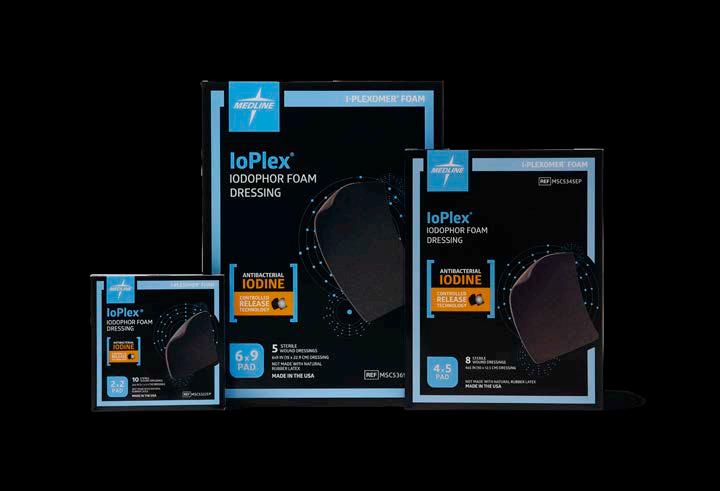
• Regulated and sustained infection management
• Iodophor foam dressing
• Changes color
• Highly conformable, gentle and stackable
Recommended Uses
• All wound depths
• All drainage levels
• As a primary dressing
Recommended Secondary Dressings
• Optifoam® Gentle
• Bordered gauze
•
To order by each, add an “H” at the end of the item number.
Indications
• Cleaning wet ulcers and wounds, including diabetic ulcers, pressure ulcers, arterial ulcers and venous stasis ulcers
• Infected traumatic wounds
• Infected surgical wounds
• Infected burns
Change Frequency
• Should be changed three times a week or when at least half of the IoPlex has changed in color from black to yellow/off white
Contraindications
• Individuals with a history of Grave’s disease, Hashimoto’s thyroiditis or goiter
• Pregnant or lactating woman

Opticell Ag+ utilizes Chytoform™, our chitosan-based gelling fiber technology, to deliver excellent benefits to wounds. Opticell Ag+ is highly absorbent and can be moistened to address dry or lightly draining wounds.
Opticell Ag+ is highly conformable and retains its shape and size in the wound better than other gelling fibers. This quality ensures that Opticell Ag+ remains in optimal and complete contact with the wound even as it absorbs moisture.
The smooth, thin and conformable profile provides for intimate contact with the wound.
Reinforced ribbon for extra strength
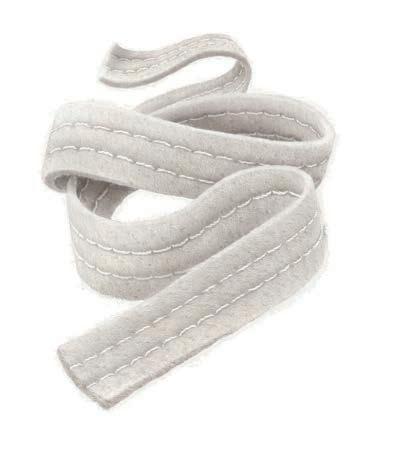
The ridges in the dressing may lead to an uneven wound contact surface.
Chytoform is the chitosan-based gelling fiber technology inside Opticell. Chitosan is derived from shellfish, bringing the science of the ocean to wound care.
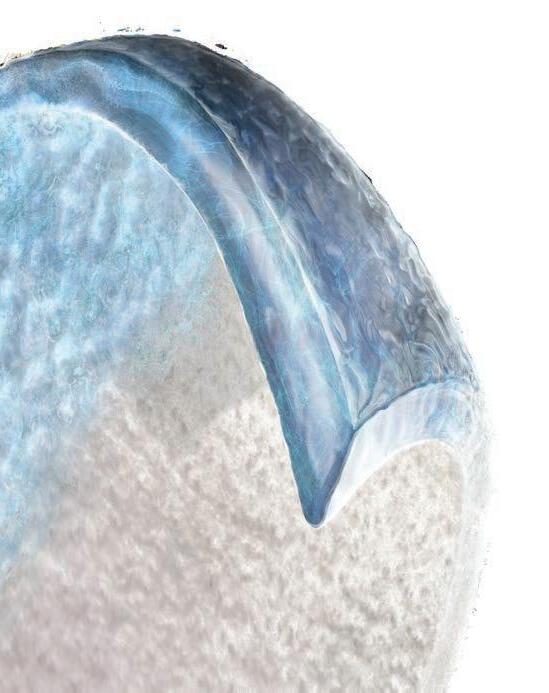
Opticell Ag+ has been shown to effectively kill microorganisms for up to 7 days, including:17
• Methicillin-resistant Staphylococcus aureus (MRSA) ATCC 33591—gram positive bacteria
• Escherichia coli ATCC 8739—gram negative bacteria
• Pseudomonas aeruginosa ATCC 9027—gram negative bacteria
• Candida albicans ATCC 10231—yeast
• Vancomycin-resistant Enterococcus faecium (VRE) ATCC 51575—gram positive bacteria
• Staphylococcus aureus ATCC 6538—gram positive bacteria
When moistened with fluid and exudate, the absorbent fibers transform into a gel
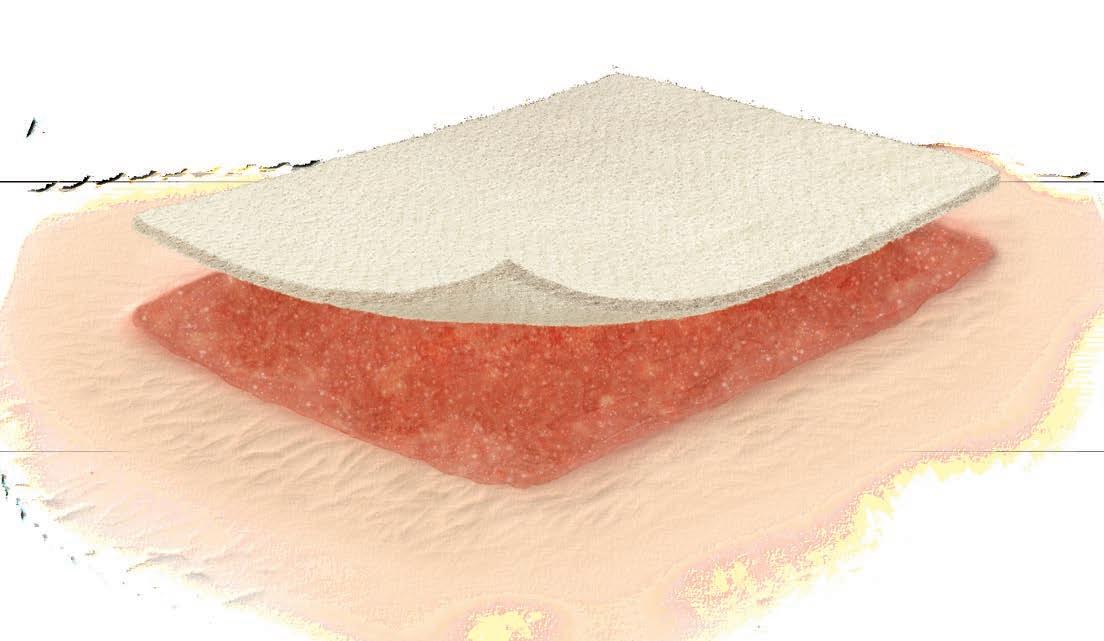
The gelling action enables effective management of drainage and removal of dead tissue
After harvesting the donor skin, Opticell is placed over the donor site
• Chytoform™ gelling fiber technology
• Broad spectrum antibacterial ionic silver
• Highly conformable
• No lateral wicking—limits maceration
• Highly absorbent 17
• Maintains a moist wound-healing environment
• Surface area memory (SAM)—retains its size
• Designed to minimize patient discomfort during removal
Recommended Uses
• All wound depths
• All drainage levels
• As a primary dressing
Recommended Secondary Dressings
• Optifoam® Gentle
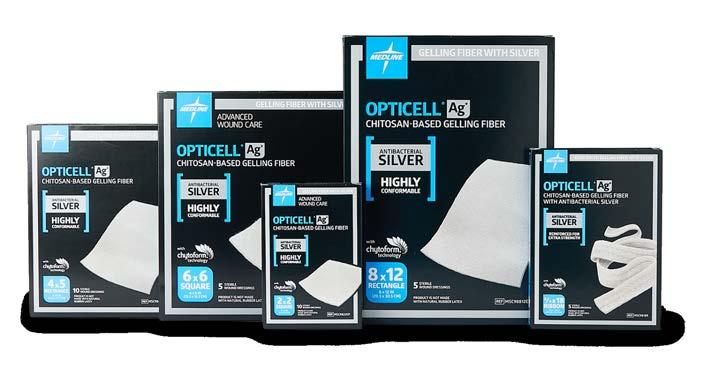
• Bordered gauze
• Stratasorb® Composite
• Gentac® Silicone Island Dressing
Indications
• Partial- and full-thickness wounds
• Venous stasis ulcers
• Pressure injuries/ulcers
• First- and second-degree burns
• Diabetic foot ulcers
• Surgical wounds
• Trauma wounds
• Donor sites
• Arterial ulcers and leg ulcers of mixed etiology
Change Frequency
• May be left in place for up to 7 days
• Dressing change frequency will depend on the amount of drainage
Contraindications
• Individuals with a sensitivity to silver or chitosan, which is derived from shellfish
Third-degree burns
To order by each, add an “H” at the end of the item number.
To order by box, add an “Z” at the end of the item number.
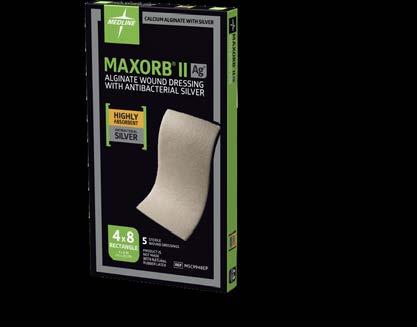
Modified Asepsis Index18
Asepsis index is a measure of 10 wound healing parameters. A lower score is preferable.
• Maxorb II is a 100% calcium alginate dressing
• Maxorb Extra is a blend of CMC and calcium alginate fibers
• Helps manage bacterial burden19,20
• Controlled-release ionic silver
• Easy dressing changes
• Highly absorbent 21
• Reduces odor22
• Reinforced silver ribbon for easy removal
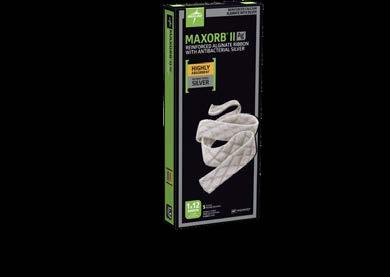
• Ribbon is ideal for tunneling or undermining wounds
• Cost-effective23
Recommended Uses
• All wound depths
• Moderate to heavy drainage levels
• As a primary dressing
Recommended
Secondary Dressings
• Optifoam® Gentle
• Stratasorb® Composite
• Bordered gauze
• Gentac Silicone Island Dressing
Indications
• Pressure injuries 22,24
• Leg ulcers
Clinical highlight
To order by each, add an “H” at the end of the item number. To order by box, add an “Z” at the end of the item number.
Sheet 2" x 2" (5.1 x 5.1 cm)
MSC9945EP Sheet 4" x 4.75" (10.2 x 12.1 cm)
MSC9948EP Sheet 4" x 8" (10.2 x 20.3 cm)
MSC9966EP Sheet 6" x 6" (15.2 x 15.2 cm)
• First- and second-degree burns 25
• Moderate to heavily draining partial- and full-thickness wounds
• Diabetic foot ulcers
• Surgical wounds
• Graft and donor sites
• Trauma wounds
Change Frequency
• Maxorb II Ag+ may be left in place for 7 days
• Maxorb Extra Ag+ may be left in place for up to 21 days18
• Dressing change frequency will depend on amount of drainage
• Third-degree burns
• Dry or lightly draining wounds
• Patients with a known sensitivity to alginate or silver
• To control heavy bleeding
• As a surgical implant
MSC99812EP Sheet 8" x 12" (20.3 x 30.5 cm)
MSC9912EP Reinforced Ribbon 1" x 12" (2.5 x 30.5 cm)
MSC9918EP Reinforced Ribbon 1" x 18" (2.5 x 45.7 cm)
Maxorb Extra Ag+
A6198 5/bx, 50/cs
A6199 5/bx, 50/cs
A6199 5/bx, 50/cs
Item No. Description HCPC Pkg.
MSC9422EP Sheet 2" x 2" (5.1 x 5.1 cm)
MSC9445EP Sheet 4" x 4.75" (10.2 x 12.1 cm)
MSC9448EP Sheet 4" x 8" (10.2 x 20.3 cm)
MSC9466EP Sheet 6" x 6" (15.2 x 15.2 cm)
MSC94812EP Sheet 8" x 12" (20.3 x 30.5 cm)
MSC9412EP Reinforced Ribbon 1" x 12" (2.5 x 30.5 cm)
Maxorb ES Ag+
A6196 10/bx, 100/cs
A6197 10/bx, 50/cs
A6197 5/bx, 50/cs
A6197 5/bx, 50/cs
A6198 5/bx, 50/cs
A6199 5/bx, 20/cs
Item No. Description HCPC Pkg.
MSC1918EP Reinforced Ribbon 0.75" x 18" (1.9 x 45.7 cm)
A6199 5/bx, 50/cs
• Ionic silver provides an antibacterial barrier26
• Continuous antibacterial protection26
• Absorbent 26
• Conformable26
• Can manage repeated bacteria introduction
• Non-staining
• Moisture vapor transmission rate (MVTR) adjusts to fluid level
• Helps create an ideal healing environment
• Waterproof, low friction and shear outer layer
Recommended Uses
• All wound depths*
• All wound drainage levels
• Primary or secondary dressing
*As a secondary dressing
Recommended Secondary Dressings**
• Medfix™ Tape
• Gentac Tape
• Medigrip™ Tubular Bandage
**Only non-bordered dressings require a secondary dressing
Indications
• Pressure injuries
• Partial- and full-thickness wounds
• Surgical wounds
• Wounds with colonization
• Ideal for managing bioburden in post-operative wounds.
• Leg ulcers
• Diabetic foot ulcers
• Donor sites
• Lacerations and abrasions
• First- and seconddegree burns
• Under compression bandages
Change Frequency
• Optifoam Ag+ may be left in place for up to 7 days

• Dressing change frequency will depend on amount of drainage
Contraindications
• Third-degree burns
• Lesions with active vasculitis
• Individuals with a known sensitivity to silver
Optifoam Ag+ has the least number of surviving colony forming units at four hours. 4 hrs at 37°C exposure to 4 sq cm of each dressing 106–107 Colony Forming Units (CFUs) initial population.
To order by each, add an “H” at the end of the item number. To order by box, add an “Z” at the end of the item number.
• Silicone dressing provides gentle adhesion
• Highly conformable27
• Moisture vapor transmission rate (MVTR) adjusts to fluid level
• Ionic silver provides an antibacterial barrier27
• Continuous antibacterial barrier protection27
• Helps maintain a moist wound-healing environment
• Waterproof outer layer
• Highly absorbent 27
• Non-staining
• Low friction and shear outer layer
Recommended Uses
• All wound depths*
• All wound drainage levels
• As a primary or secondary dressing
*May be used as a secondary dressing for deep wounds
Recommended
Secondary Dressings**
• Gentac™ tape
• Elastic net
• Medigrip™ Tubular Bandage
**Only non-bordered dressings require a secondary dressing
• Pressure injuries
• Partial- and shallow full-thickness wounds
• Surgical wounds
• Wounds with colonization
• Leg ulcers
• Diabetic foot ulcers
• Donor sites
• Lacerations and abrasions
• Skin tears
• First- and seconddegree burns
Change Frequency
• Optifoam Gentle Ag+ may be left in place for up to 7 days
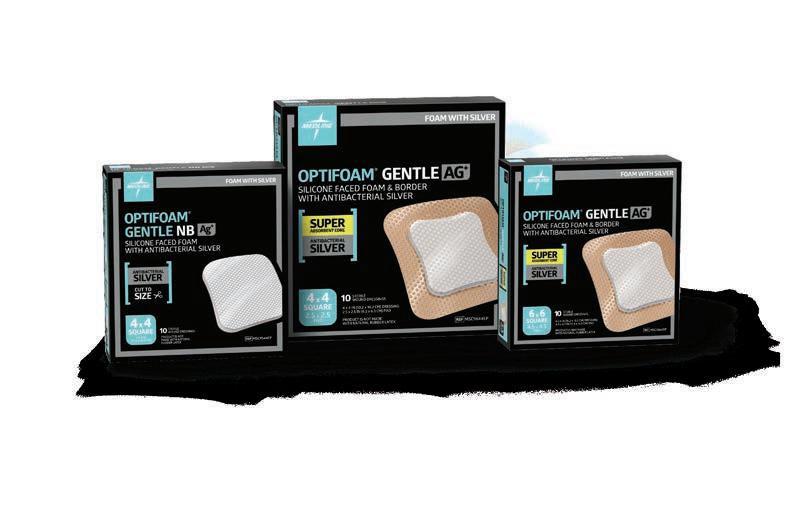
• Dressing change frequency will depend on amount of drainage
• Third-degree burns
• Lesions with active vasculitis
• Individuals with a known sensitivity to silver
• As a surgical implant
Antibacterial Silicone-Faced and Bordered Foam Dressing
Antibacterial Non-Bordered Silicone-Faced Foam Dressing
Antibacterial Silicone-Bordered Foam Dressing
• Ionic silver provides antibacterial barrier29 over incision sites
• Continuous antibacterial protection29
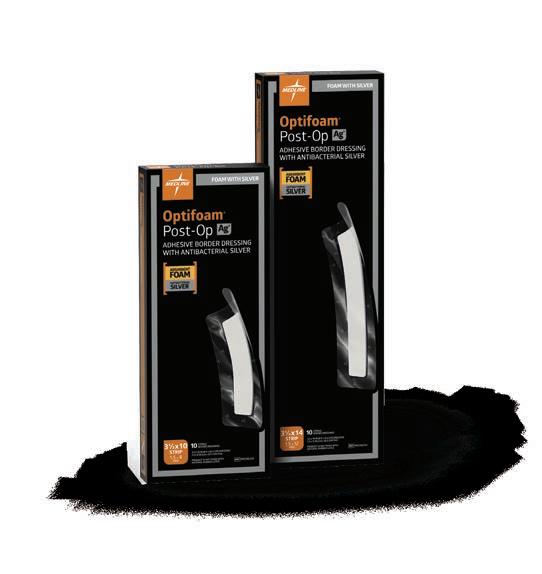
• Thin, conformable adhesive border
• Can manage repeated bacteria introduction
• Non-staining
• Waterproof backing
• Moisture vapor transmission rate (MVTR) adjusts to fluid level
• Helps maintain a moist wound-healing environment
Recommended Uses
• Incision sites
• All wound drainage levels
• As a primary or secondary dressing
Indications
• Post-operative wounds
Change Frequency
• Optifoam Ag+ Post-Op may be left in place for up to 7 days
• Dressing change frequency will depend on amount of drainage
Contraindications
• Third-degree burns
• Lesions with active vasculitis
• Individuals with a known sensitivity to silver
To order by each, add an “H” at the end of the item number. To order by box, add an “Z” at the end of the item number.
Antibacterial Acrylic-Bordered Post-Op Dressings
In the direct kill assay, Optifoam Gentle Ag+ reduced the microbial numbers below the limit of detection and reduced viability by a log of four within 24 hours against S. aureus, P. aeruginosa and C. albicans
• Ionic silver provides antibacterial barrier29 over incision sites
• Continuous antibacterial protection29
• Thin, conformable adhesive border
• Can manage repeated bacteria introduction
• Non-staining
• Waterproof backing
• Moisture vapor transmission rate (MVTR) adjusts to fluid level
• Helps maintain a moist wound-healing environment
• Silicone adhesive border
Recommended Uses
• Incision sites
• All wound drainage levels
• As a primary or secondary dressing
Indications
• Post-operative wounds
Change Frequency
• Optifoam Gentle Ag+ Post-Op may be left in place for up to 7 days
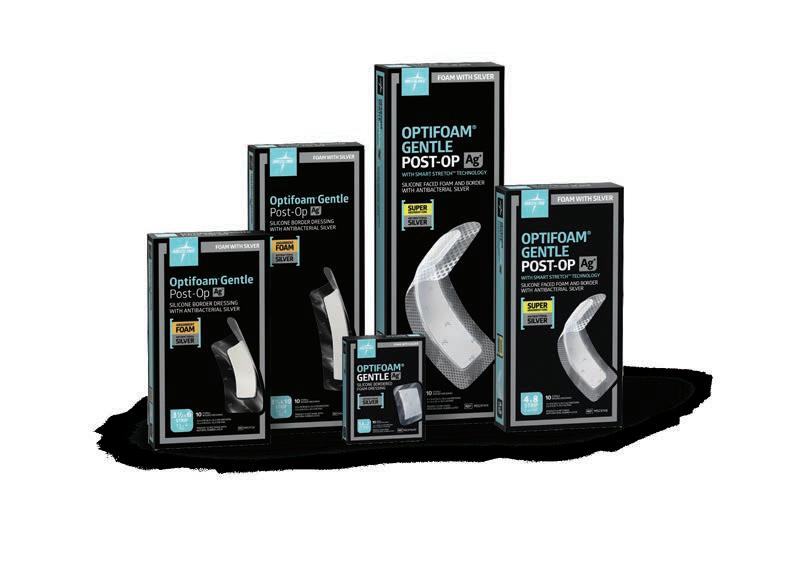
• Dressing change frequency will depend on amount of drainage
Contraindications
• Third-degree burns
• Lesions with active vasculitis
• Individuals with a known sensitivity to silver
To order by each, add an “H” at the end of the item number. To order by box, add an “Z” at the end of the item number.
Antibacterial Silicone-Faced and Bordered Post-Op Dressings
MSC97412
MSC97414
x 10" (10.2 x 25.4 cm);
x 8" (5.1 x 20.3 cm) Pad
x 12" (10.2 x 30.5 cm);
x 10" (5.1 x 25.4 cm) Pad
x 14" (10.2 x 35.6 cm); 2" x 12" (5.1 x 30.5 cm) Pad
10/bx, 100/cs
10/bx, 100/cs
10/bx, 100/cs
Antibacterial Silicone-Bordered Post-Op Dressings
Item No. Description HCPC Pkg.
MSC97162EP 1.6" x 2" (4.1 x 5.1 cm); 0.8" x 1.2" (2 x 3 cm) Pad
MSC9736 3.5" x 6" (8.9 x 15.2 cm);
10/bx, 70/cs
1.5" x 4" (3.8 x 10.2 cm) Pad A6212 10/bx, 100/cs
MSC97310 3.5" x 10" (8.9 x 25.4 cm);
1.5" x 8" (3.8 x 20.3 cm) Pad A6212 10/bx, 100/cs
MSC97314 3.5" x 14" (8.9 x 35.6 cm); 1.5" x 12" (3.8 x 30.5 cm) Pad A6213 10/bx, 100/cs
Clinical highlight
• Ionic silver provides antibacterial barrier30 over incision sites
• Continuous antibacterial effect 29
• Can manage repeated bacteria introduction30
• Non-staining
• Hydrocolloid adhesive border
• Highly breathable film to help maintain moisture balance within incision site
Recommended Uses
• Incision sites
• All wound drainage levels
• As a primary or secondary dressing
Indications
• Post-operative wounds
Change Frequency
• PrimaSeal Post-Op Ag+ may be left in place for up to 7 days
• Dressing change frequency will depend on amount of drainage
Contraindications
• Individuals with a known sensitivity to dressing components
PrimaSeal Post-Op Ag+ achieves a faster 4 log kill than a competitive surgical dressing

Numbers of hours required to achieve 4 log kill within first 6 hours of microbe exposure30 Pseudomonas aeruginosa E. Coli
To order by each, add an “H” at the end of the item number. To order by box, add an “Z” at the end of the item number.
x 25 cm), 2" x 8.4" (5.1 x 21 cm) Pad A6197 10/bx, 100/cs
MSCPS312 3.5" x 12" (9 x 30 cm), 2" x 10" (5.1 x 26 cm) Pad A6197 10/bx, 100/cs
MSCPS314 3.5" x 14" (9 x 35 cm), 2" x 12" (5.1 x 30 cm) Pad A6197 10/bx, 100/cs
MSCPS615 TKR Design 6" x 15" (15.2 x 38.1 cm), 2" x 11.8" (5.1 x 30 cm) Pad
50/cs
Survival Curve with SilvaSorb31
• Helps manage bacterial burden31,32
• Ionic silver
• Continuous antimicrobial protection31,33
• Non-staining31
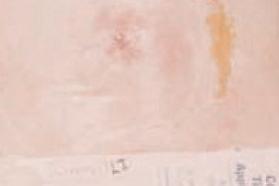
• Gentle for the patient 34,35
• Advanced fluid management 31
• Extended wear time33,36,37
Recommended Uses
• All wound depths
• Light to moderately draining wounds
• As a primary dressing
Recommended
Secondary Dressings
• Stratasorb Composite
• Bordered gauze
• Optifoam Gentle
• Gentac Silicone Island Dressing
• Pressure injuries
• Partial- and full-thickness wounds
• Leg ulcers
• Diabetic foot ulcers
• Graft wounds and donor sites
• Skin tears
• Surgical wounds
• Lacerations and abrasions
• First- and second-degree burns
Change Frequency
• Amorphous gel may be left in place for up to 3 days
• Dressing change frequency will depend on amount of drainage
• Individuals with a known sensitivity to silver
SilvaSorb has powerful antimicrobial activity (in vitro), 6–8 log reduction within 4 hours.
A 93 year-old wheelchair-bound male with no significant nutritional deficits developed a chronic trochanteric pressure ulcer. The ulcer was treated with various wound care therapies for four months without progress. The wound bed was friable and therefore presumptive for high bioburden. It was elected to start an antimicrobial dressing in conjunction with off-loading the affected hip. Closure was attained within four weeks.
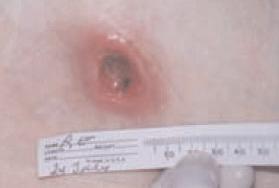
Before After 4 weeks
To order by each, add an “H” at the end of the item number.
Item No. Description HCPC Pkg.
MSC93025EP Gel, 0.25 oz (7.08 g), Tube A6248 25/bx
MSC9301EP Gel, 1.5 oz (42.5 g), Tube A6248 12/cs
MSC9303EP Gel, 3 oz (85 g), Tube A6248 12/cs
MSC9308EP Gel, 8 oz (226.7 g), Tube A6248 6/cs
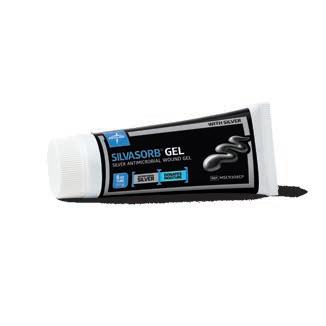
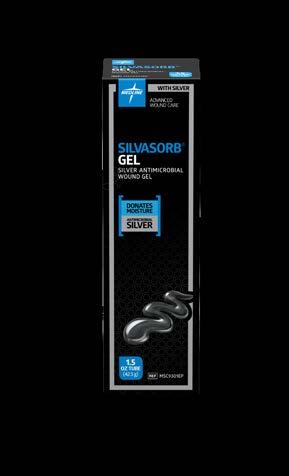
MSC9310EP 1" (2.5 cm) Circular with Slit A6242 30/cs
MSC9344EP 4" x 4" (10.2 x 10.2 cm) Sheet A6243 25/cs
Powerful antimicrobial activity—up to a six log reduction (in vitro studies)
• Manages bacterial burden39
• Continuous antimicrobial protection39
• Extended wear time39
• Non-staining
• An ideal complement when used with other wound dressings
Recommended Uses
• All wound depths
• Light to heavily draining wounds
• As a primary dressing
Recommended
Secondary Dressings
• Stratasorb Composite
• Bordered gauze
• Gentac Silicone Island
Indications
• Pressure injuries
• Diabetic foot ulcers 40
• Partial- and full-thickness wounds
• Leg ulcers
• Negative pressure wound therapy
• Grafted wounds
• Donor sites
• Lacerations and abrasions
• First- and second-degree burns
Change Frequency
• Ag+ Powder may be left in place for up to 5 days
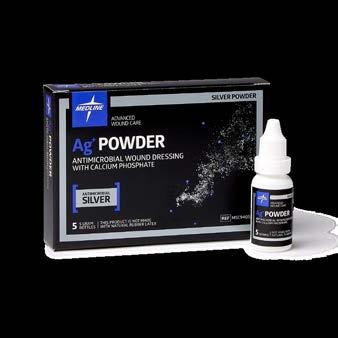
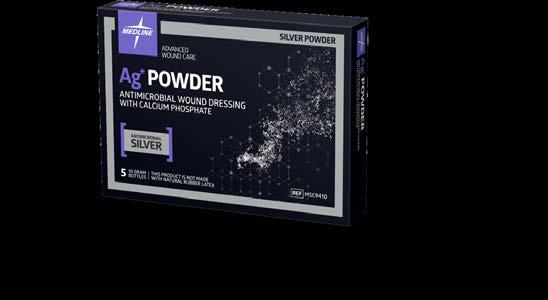
• Dressing change frequency will depend upon the amount of drainage
Contraindications
• Third-degree burns
• Patients with a known sensitivity to silver
• As a surgical implant
• Do not use topical antibiotics in conjunction with Ag+ Powder
To order by each, add an “H” at the end of the item number. To order by box, add an “Z” at the end of the item number.
Achieving the right moisture balance can be a challenge. Too much moisture can lead to periwound maceration and skin breakdown, while too little moisture can impede cellular activities and promote eschar formation, resulting in poor wound healing.
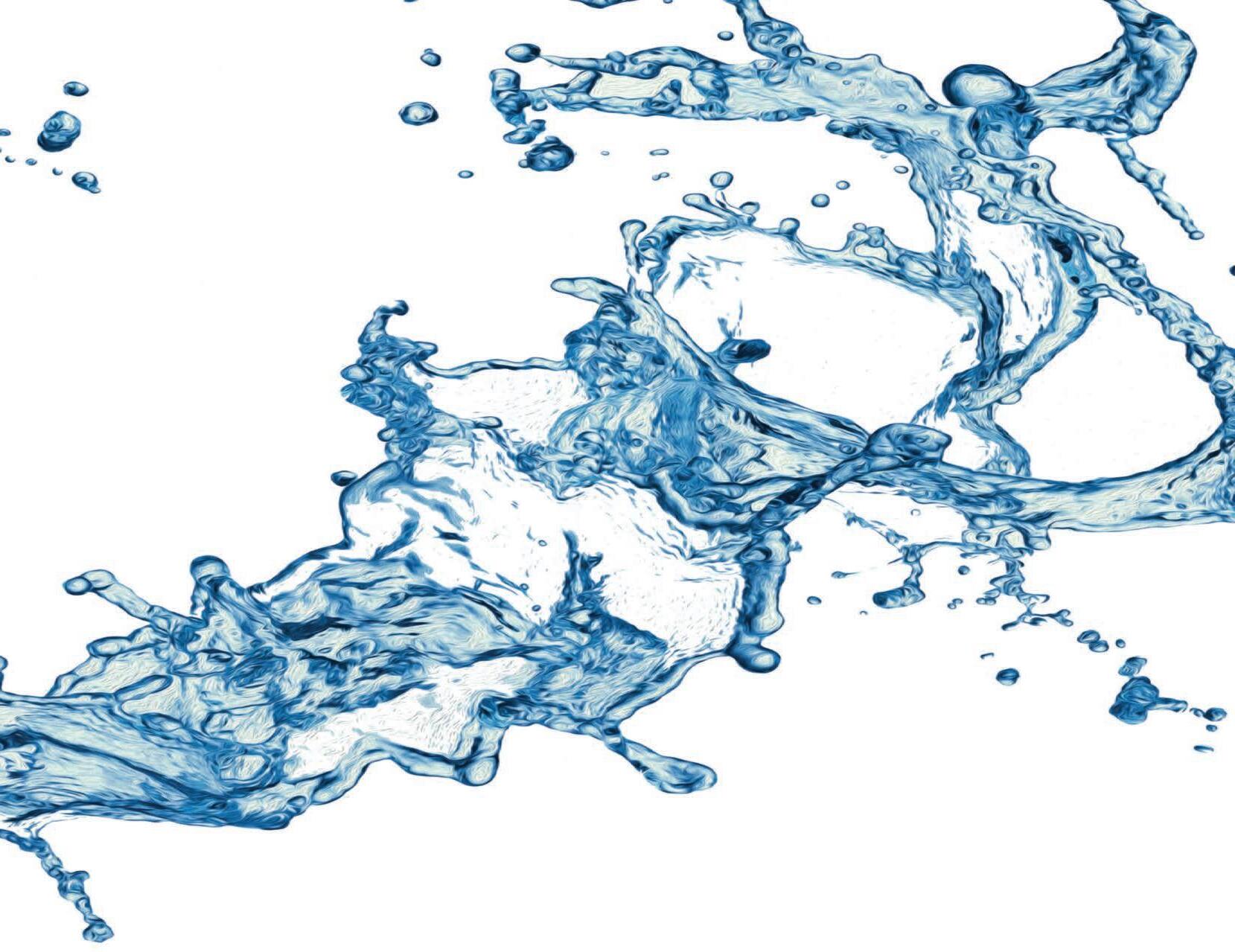
Optifoam Gentle helps ease the discomfort and trauma of dressing changes. Featuring a specially-formulated silicone adhesive that helps keep it in place, Optifoam’s superabsorbent core absorbs and retains fluid, protects against infection*, and helps protect against shear and friction.
Foam dressings can be used as part of a pressure injury prevention protocol.
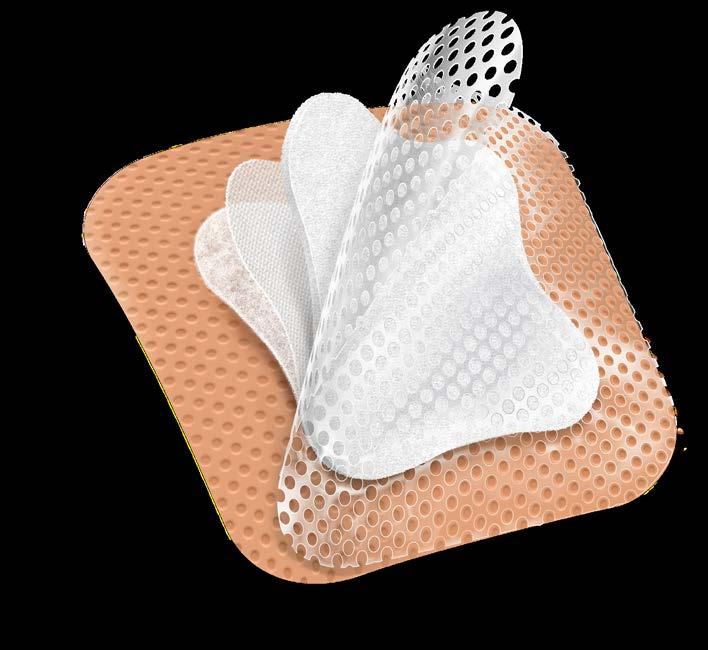
Studies in the evaluation of the use of a foam dressing with silicone border on patients at risk for hospital acquired pressure injuries (HAPI) resulted in a significant reduction in pressure ulcers over a 3-month period with lower monthly incidence and enhanced prevention.42
Absorbency and retention
• Light
• Moderate
• Heavy
• Extra heavy
Antibacterial
Location of silicone
• Face
• Border
• Face and border
• Ag+ version only
Foam and superabsorbent core absorb and retain exudate
Silicone adhesive minimizes trauma and reduces discomfort upon wear or removal
*Available
Shape
• Sacral
• Square
• Rectangle
• Heel
Customizable
• Non-border dressings can be cut for conformability
Waterproof film keeps dirt and germs out
• Silicone adhesive provides gentle adhesion
• Highly conformable 43 dressing can be lifted and reapplied
• Moisture vapor transmission rate (MVTR) adjusts to fluid level
• Highly absorbent43
• Helps create ideal healing environment
• Waterproof outer layer protects wound and keeps dirt and germs out
• Low friction and shear outer layer
Recommended Uses
• As a primary or secondary dressing
• All wound depths*
*May be used as a secondary dressing for deep wounds
• All wound drainage levels:
Recommended Secondary Dressings*
• Gentac Tape
• Elastic net
• Medigrip Tubular Bandage
**Applies to Optifoam Silicone-Faced Foam only
Indications
• Pressure injuries
• Partial- and full-thickness wounds
• Leg ulcers
• Donor sites
• Lacerations and abrasions
• Skin tears
• First- and second-degree burns
Change Frequency
• Optifoam Gentle may be left in place for up to 7 days
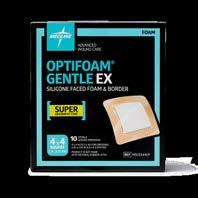
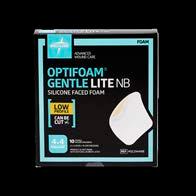
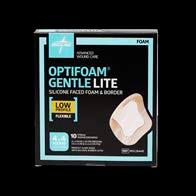
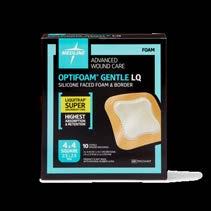

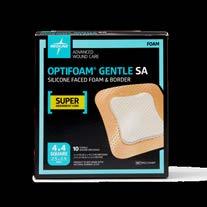
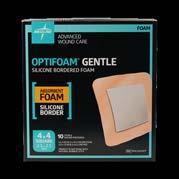
• Dressing change frequency will depend on amount of drainage
Contraindications
• Third-degree burns
To order by each, add an “H” at the end of the item number. To order by box, add an “Z” at the end of the item number.
Optifoam Gentle LQ
Silicone-faced foam and border dressing with Liquitrap core
MSC2333EP 3" x 3" (7.6 x 7.6 cm);
Pad: 1.75" x 1.75" (4.4 x 4.4 cm)
MSC2344EP 4" x 4" (10.2 x 10.2 cm);
Pad: 2.5" x 2.5" (6.4 x 6.4 cm)
MSC2366EP 6" x 6" (15.2 x 15.2 cm);
Pad: 4.5" x 4.5" (11.4 x 11.4 cm)
MSC2377EP Sacrum: 7" x 7" (17.8 x 17.8 cm)
MSC2399EP Sacrum: 9" x 9" (22.8 x 22.8 cm)
Optifoam Gentle SA
10/bx, 100/cs
10/bx, 100/cs
10/bx, 100/cs
5/bx, 40/cs
10/bx, 100/cs
Silicone-faced foam and border dressing with superabsorbent core
MSC2133EP 3" x 3" (7.6 x 7.6 cm); Pad: 1.75" x 1.75" (4.4 x 4.4 cm)
MSC2144EP 4" x 4" (10.2 x 10.2 cm);
Pad: 2.5" x 2.5" (6.4 x 6.4 cm)
MSC2166EP 6" x 6" (15.2 x 15.2 cm); Pad: 4.5" x 4.5" (11.4 x 11.4 cm)
Optifoam Gentle Post-Op
Silicone-faced and bordered post-operative foam dressing with superabsorbent core
Item No. Description
MSC2148 4" x 8" (10.2 x 20.3 cm);
Pad: 2" x 6" (5.1 x 15.2 cm)
MSC21410 4" x 10" (10.2 x 25.4 cm);
Pad: 2" x 8" (5.1 x 20.3 cm)
MSC21412 4" x 12" (10.2 x 30.5 cm);
Pad: 2" x 10" (5.1 x 25.4 cm)
Optifoam Gentle Silicone-bordered foam dressing
Item No. Description
MSC20162EP 1.6" x 2" (4.0 x 5.0 cm);
Pad: 0.8" x 1.2" (2.0 x 3.0 cm)
HCPC Pkg.
A6254 10/bx, 100/cs
A6254 10/bx, 100/cs
A6255 10/bx, 100/cs
HCPC Pkg.
A6213 10/bx, 70/cs
10/bx, 100/cs
10/bx, 100/cs
MSC2033EP 3" x 3" (7.6 x 7.6 cm); Pad: 1.5" x 1.5" (3.8 x 3.8 cm)
MSC2044EP 4" x 4" (10.2 x 10.2 cm); Pad: 2.5" x 2.5" (6.4 x 6.4 cm)
MSC2066EP 6" x 6" (15.2 x 15.2 cm);
4.5" x 4.5" (11.4 x 11.4 cm)
MSC2077EP Sacrum: 7" x 7" (17.8 x 17.8 cm)
MSC20109EP Sacrum: 10" x 9" (25.4 x 22.9 cm)
Optifoam Gentle Non-bordered
10/bx, 100/cs
10/bx, 100/cs
5/bx, 50/cs
5/bx, 50/cs
Optifoam Gentle EX
x 22.8 cm)
Silicone-faced foam and border dressing with superabsorbent core
Item No. Description
MSCEX33EP 3" x 3" (7.6 x 7.6 cm)
MSCEX44EP 4" x 4" (10.2 x 10.2 cm)
MSCEX55EP 5" x 5" (12.5 x 12.5
Non-bordered silicone-faced foam dressing Item No. Description
4" x 4" (10.2 x 10.2 cm) A6209 10/bx, 100/cs
MSC2266EP 6" x 6" (15.2 x 15.2 cm) A6210 10/bx, 100/cs
MSC2288EP 8" x 8" (20.3 x 20.3 cm) A6211 5/bx, 50/cs
Optifoam Gentle Lite
Lite silicone-faced and bordered foam dressing
Item No. Description HCPC Pkg.
MSC28162B 1.6" x 2" (4 x 5 cm) A6413 10/bx, 100/cs
MSC2833B 3" x 3" (7.6 x 7.6 cm) A6212 10/bx, 100/cs
MSC2844B 4" x 4" (10.2 x 10.2 cm) A6212 10/bx, 100/cs
MSCEX99EP
MSC2866B 6" x 6" (15.2 x 15.2 cm) A6213 10/bx, 100/cs
Optifoam Gentle Lite Non-bordered
Lite non-bordered silicone-faced foam dressing
Item No. Description HCPC Pkg.
MSC2944NB 4" x 4" (10.2 x 10.2 cm) A6209 10/bx, 100/cs
MSC2966NB 6" x 6" (15.2 x 15.2 cm) A6210 10/bx, 100/cs
Coefficient of Friction of Film Backing44
Optifoam Heel has 50% less friction than the leading heel shaped dressing
• Moisture vapor transmission rate (MVTR) adjusts to fluid level
• Absorbent
• Helps create an ideal healing environment
• Waterproof outer layer protects wound and keeps dirt and germs out (except Optifoam Basic)

Recommended Uses
• All wound depths*
• All wound drainage levels
• As a primary or secondary dressing
*May be used as a secondary dressing for deep wounds
Recommended
Secondary Dressings**
• Medfix™ Tape
• Gentac™ Tape
• Medigrip™ Tubular Bandage
**Applies only to Optifoam NonAdhesive, Optifoam Basic and Optifoam Heel
To order by each, add an “H” at the end of the item number. To order by box, add an “Z” at the end of the item number.
Optifoam Heel absorbs 44% more under compression than the leading heel shaped dressing
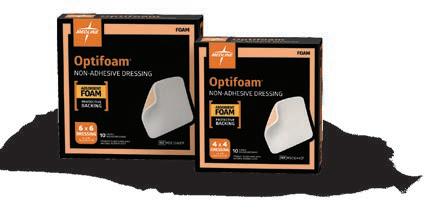
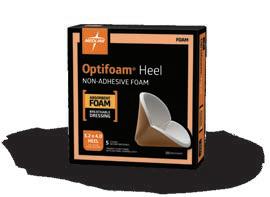
Optifoam Adhesive
Adhesive bordered foam dressing Item No. Description HCPC Pkg.
MSC1044EP 4" x 4" (10.2 x 10.2 cm),
2.5" x 2.5" (6.4 x 6.4 cm)
MSC1066EP 6 x 6" (15.2 x 15.2 cm), Pad: 4.5 x 4.5" (11.4 x 11.4 cm)
MSC1065EP Sacrum: 6" x 5.5" (15.5 x 14.2 cm)
Optifoam Non-Adhesive
Non-bordered foam dressing
Indications
• Pressure injuries
• Partial- and fullthickness wounds
• Leg ulcers
• Donor sites
• Lacerations and abrasions
• Skin tears
• First- and second-degree burns
Change Frequency
• May be left in place for up to 7 days
• Dressing change frequency will depend on amount of drainage
• Third-degree burns
• Lesions with active vasculitis
Optifoam Heel
Heel-shaped, non-adhesive foam dressing
Optifoam Basic
Foam dressing without polyurethane layer
10/bx, 100/cs
100/cs
Optifoam Site
Circular site dressing with radial slit and starburst opening
Item No. Description HCPC Pkg.
MSC1104 4" (10.2 cm) Adhesive Dressing, 2" Pad A6212 30/bg, 120/cs
MSC1102 2" (5.1 cm) Non-Adhesive Pad A6209 10/bx, 100/cs
Optifoam Thin
Thin, adhesive-faced dressing
Item No. Description HCPC Pkg. MSC1523EP 2" x 3" (5.1 x 7.6 cm)
MSC1544EP 4" x 4" (10.2 x 10.2 cm)
10/bx, 100/cs
10/bx, 100/cs
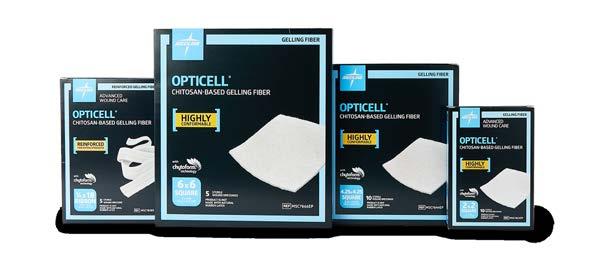
Highly conformable
Surface Area Memory (SAM) Results45
• Chytoform™ gelling fiber technology
• Controls minor bleeding
• Highly conformable
• No lateral wicking limits maceration
• Highly absorbent45
• Maintains a moist woundhealing environment
• Surface area memory (SAM)—retains its size
• Gentle removal from the wound
• Designed to minimize pain upon removal
Recommended Uses
• All wound depths
• All drainage levels
• As a primary dressing
Recommended Secondary Dressings
• Optifoam® Gentle
• Bordered gauze
• Stratasorb® Composite
• Gentac Silicone Island
Indications
• Partial- and fullthickness wounds
• Venous stasis ulcers
• Pressure injuries
• First- and second-degree burns
• Diabetic foot ulcers
• Surgical wounds
• Trauma wounds
• Donor sites
• Arterial ulcers and leg ulcers of mixed etiology
• Oncology wounds
Change Frequency
• Opticell® may be left in place for up to 7 days
• Opticell may remain in place up to 14 days in the context of burn treatment
• Dressing change frequency will depend on the amount of drainag
• Individuals with a sensitivity to silver or chitosan, which is derived from shellfish
• Third-degree burns
highlights
Retains its shape and size to maintain complete wound coverage.1
To order by each, add an “H” at the end of the item number. To order by box, add an “Z” at the end of the item number.
Maxorb II Absorbency Comparison47
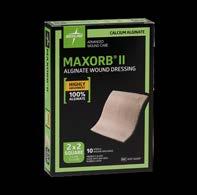
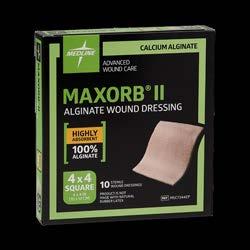
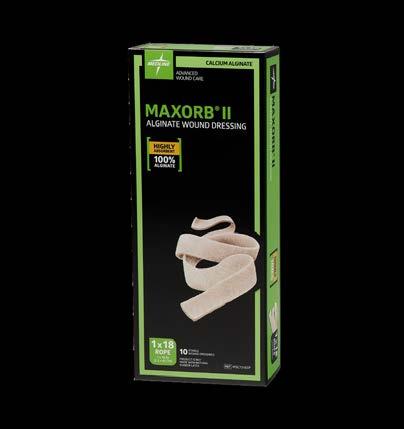
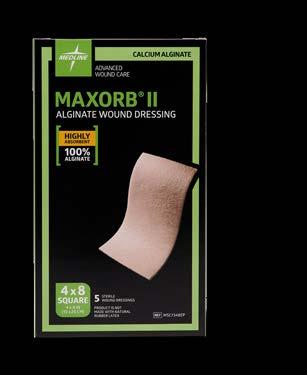
• Maxorb II is a 100% calcium alginate dressing
• Maxorb Extra is a blend of CMC and calcium alginate fibers
• Maxorb ES is reinforced for easy removal from tunneling wounds
• Superior fluid handling47
• High wet strength— removes in one piece
• Fluid does not wick laterally
• Improved gelling capability
Recommended Uses
• All wound depths
• Moderate/heavy drainage
• As a primary dressing
Recommended
Secondary Dressings
• Optifoam® Gentle
• Bordered gauze
• Stratasorb® Composite
• Gentac Silicone Island Dressing
Indications
• Pressure injuries
• Partial- and full-thickness wounds
• Leg ulcers
• Diabetic ulcers
• Surgical wounds
• Donor sites
• Lacerations and abrasions
Clinical highlight
To order by each, add an “H” at the end of the item number. To order by box, add an “Z” at the end of the item number. Maxorb
• First- and second-degree burns
Change Frequency
• May be left in place for up to 7 days
• Dressing change frequency will depend on the amount of drainage
Contraindications
• Individuals with a known sensitivity to alginates
• Third-degree burns
• To control heavy bleeding
• As a surgical sponge
• Dry or lightly draining wounds
x 12" (2.5 x 30.5 cm)
MSC7318EP Reinforced Ribbon 1" x 18" (2.5 x 45.7 cm)
Maxorb Extra
A6199 10/bx, 50/cs
A6199 10/bx, 50/cs
Item No. Description HCPC Pkg.
MSC7022EP Sheet 2" x 2" (5.1 x 5.1 cm)
MSC7044EP Sheet 4" x 4" (10.2 x 10.2 cm)
MSC7048EP Sheet 4" x 8" (10.2 x 20.3 cm)
MSC7012EP CMC/Alginate Ribbon 1" x 12" (2.5 x 30.5 cm), Rope
MSC7112EP CMC/Alginate Ribbon 1" x 12" (2.5 x 30.5 cm), Flat Rope
Maxorb ES
A6196 10/bx, 100/cs
A6196 10/bx, 50/cs
A6197 5/bx, 50/cs
A6199 5/bx, 20/cs
A6196 5/bx, 20/cs
Item No. Description HCPC Pkg.
MSC7918EP Reinforced Ribbon 0.75" x 18"” (1.9 x 45.7 cm)
A6199 5/bx, 50/cs
Clinical highlights
• Superabsorbent polymer core
• Locks in drainage under compression
• Adjusts absorption to the amount of drainage
• Protects skin from maceration
• Non-adherent wound contact layer
Recommended Uses
• All wound depths*
• Moderate to heavy drainage
• As a primary dressing
*May be used as a secondary dressing for deep wounds
Recommended
Secondary Dressings
• Medfix™ Tape
• Elastic net
• Gentac® Tape
• TwoFlex
• Accuwrap
Indications
• Pressure injuries
• Partial- and fullthickness wounds
• Leg ulcers
• Lacerations and abrasions
• Wounds under compression
Change Frequency
• OptiLock may be left in place for up to 7 days
• Dressing change frequency will depend on amount of drainage
Contraindications
• Third-degree burns
• Individuals with a known sensitivity to the product itself or its components
OptiLock is ideal for highly draining venous leg ulcers because of its gentle contact layer and fluid-locking feature. Even under high compression bandages, the fluid is retained in the dressing. Use OptiLock in conjunction with AccuWrap compression bandage system. To learn more, see pg. 50.
Fluid Loss Under Compression1
OptiLock dressings retain substantially more fluid under compression than a leading silicone-faced foam dressing.
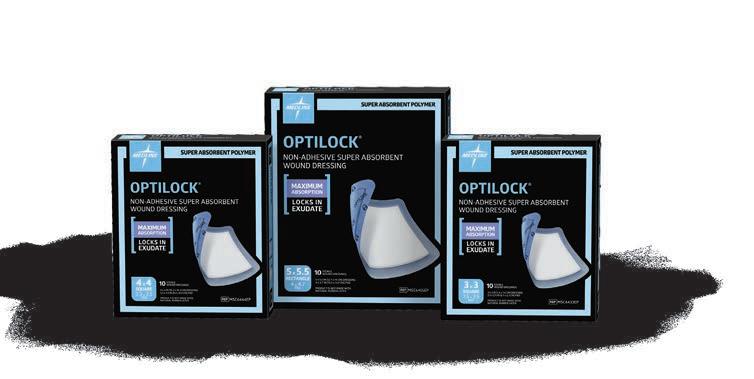
Absorption Capacity Under Compression1
OptiLock absorbs approximately three times more fluid than a leading silicone-faced foam dressing.
In manufacturer’s laboratory testing, Medline’s OptiLock dressings outperformed a leading silicone-faced foam dressing. OptiLock’s remarkable absorption and fluid retention capabilities raise the bar for gentle wound care. OptiLock
To order by each, add an “H” at the end of the item number. To order by box, add an “Z” at the end of the item number.
MSC64610EP 6.5" x 10" (16.5 x 25.4 cm) A6198 10/bx, 50/cs
MSC64812EP 8" x 12" ( 20.3 x 30.5 cm) A6198 10/bx, 80/cs
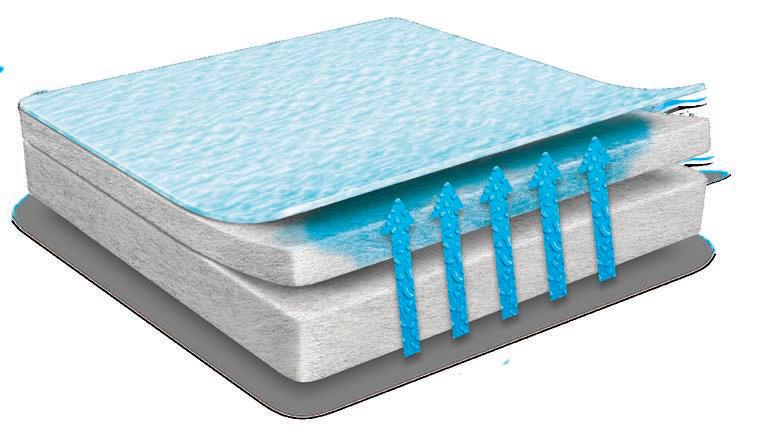
Aquaconductive Technology is the mechanism by which the three layers of Qwick pull exudate away from or out of the wound to help create an optimal wound healing environment.
The blue layer is the top layer, which faces away from the wound and helps serve as an indicator of how the dressing should be applied. Exudate can pass through this layer into a secondary dressing.
The storage layer consists of super absorbent polyacrylate fibers designed to absorb and retain large amounts of exudate.
Absorbency (g/100 cm2)
The wound contact layer is composed of a blend of hydrophobic and hydrophilic fibers. Hydrophilic fibers attract exudate, resulting in fast wicking. Hydrophobic fibers regulate and channel exudate vertically, away from the wound and into the storage layer.
Clinical highlights
Fluid Retention Under Compression (g/100 cm2)
Qwick dressing is nearly twice as absorbent as the competitor’s dressing.
Qwick can retain nearly 60% more fluid than the competitor’s dressing under pressure.
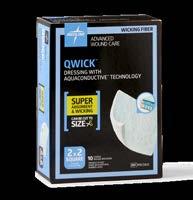
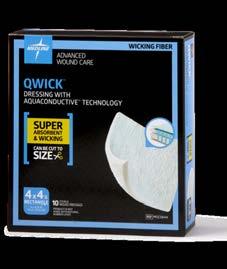

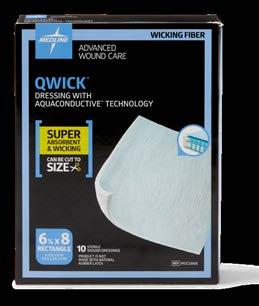
• Multilayer construction wicks and retains fluid to help protect the skin from maceration
• Can be cut to fit
• Flexible
• Superabsorbent
• Wicking
• Featuring Aquaconductive™ Technology
• Can be used as a transfer layer
Recommended Uses
• All wound depths
• Moderate to heavy drainage
• As a primary dressing
Recommended Secondary Dressings
• Bordered gauze
• Gentac® Silicone Island Dressing
• Optifoam® Gentle
• Elastic net
Indications
• Pressure injuries
• Partial- and full-thickness wounds
• Leg ulcers
• Lacerations and abrasions
• Wounds under compression
Change Frequency
• Qwick may be left in place for up to 7 days
• Dressing change frequency will depend on the amount of drainage
Contraindications
• Third-degree burns
To order by each, add an “H” at the end of the item number. To order by box, add an “Z” at the end of the item number.
To order by each, add an “H” at the end of the item number.
Exuderm Satin Hydrocolloid Hydrocolloid wound dressings with satin-finish backing
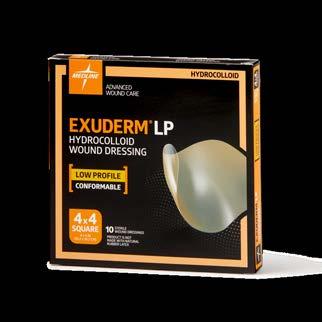
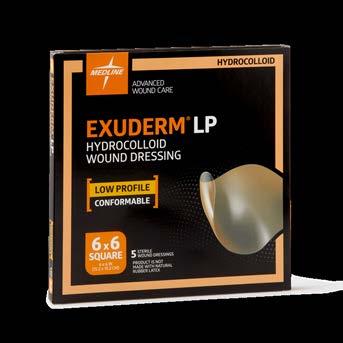
• Manages drainage50 to help maintain a moist wound healing environment
• Longer wear time
• Protective, occlusive barrier
• Satin-finish backing is low friction for longer wear time
Recommended Uses
• All wound depths*
• All drainage levels
• As a primary dressing
*May be used as a secondary dressing for deep wounds
• Pressure injuries
• Partial- and fullthickness wounds
• Leg ulcers
• Donor sites
• Wounds with light to moderate drainage
• Lacerations and abrasions
• First- and second-degree burns
• Exuderm dressings can be left in place for up to 7 days
• Dressing change frequency will depend on amount of drainage
• Third-degree burns
Exuderm Odorshield Hydrocolloid
Hydrocolloid wound dressings with cyclodextrins to absorb and control odor
6" x 6.5" (16.3 x 16.5 cm)
Exuderm LP Low Profile Hydrocolloid Thin hydrocolloid dressings
Exuderm RCD Traditional Hydrocolloid Hydrocolloid wound dressings with foam backing
Cytotoxicity Test for Skintegrity Hydrogel51
Using Murine L929 Embryo Fibroblasts
• Donate moisture
• Rinse easily from the wound
• Skintegrity 1-oz. bellows bottle reduces waste and eases application
• Skintegrity Hydrogel Impregnated Gauze combines gauze with hydrogel for easy delivery to wounds that require packing
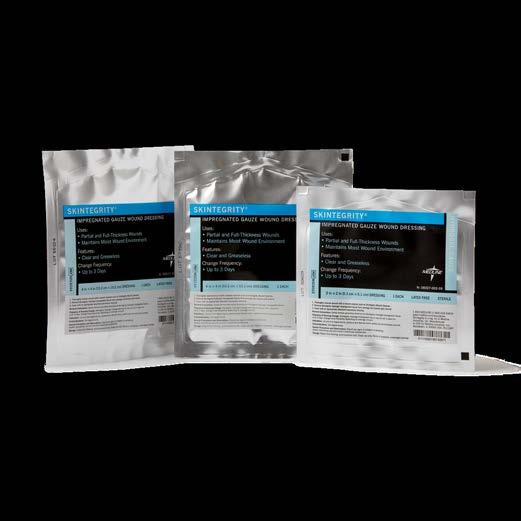
• Carrasyn Hydrogel available in an 8-oz. spray bottle
Recommended Uses
• All wound depths
• No/minimal drainage
• As a primary dressing
Recommended Secondary Dressings
• Bordered gauze
• Stratasorb® Composite
• Gentac® Silicone Island Dressing
Indications
• Pressure injuries
• Partial- and full-thickness wounds
• Leg ulcers
• Surgical wounds
• Lacerations, abrasions and skin tears
• First- and second-degree burns
• Skintegrity, Radiadres and Carradres may be left in place for up to 3 days
• Dressing change frequency will depend on amount of drainage
• Patients with a known sensitivity to components of the gel
• Heavily draining wounds
Clinical highlight
To order by each, add an “H” at the end of the item number. To order by box, add an “Z” at the end of the item number.
Skintegrity® Hydrogel
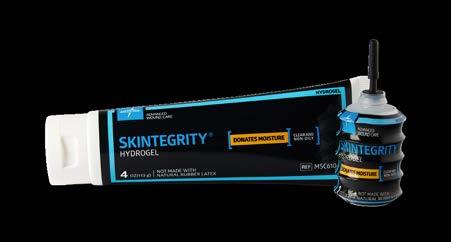
Skintegrity® Hydrogel Impregnated Gauze
MSC6044 Skintegrity Woven, 12-Ply: 4" x 4" (10.2 x 10.2 cm)
x 10.2 cm)
Radiadres and Carradres Hydrogel Sheets
If the wound edge isn't migrating after appropriate wound bed preparation (debridement, infection/ inflammation, moisture balance) and healing is stalled, advanced therapies should be considered.
Venous ulcers, pressure injuries, diabetic ulcers and surgical incisions are all wounds that may be likely to stall. What can you do when this happens?
One approach is adding collagen. As one of the body’s primary natural resources and a component within the dermis, collagen plays a key role in each phase of wound healing.
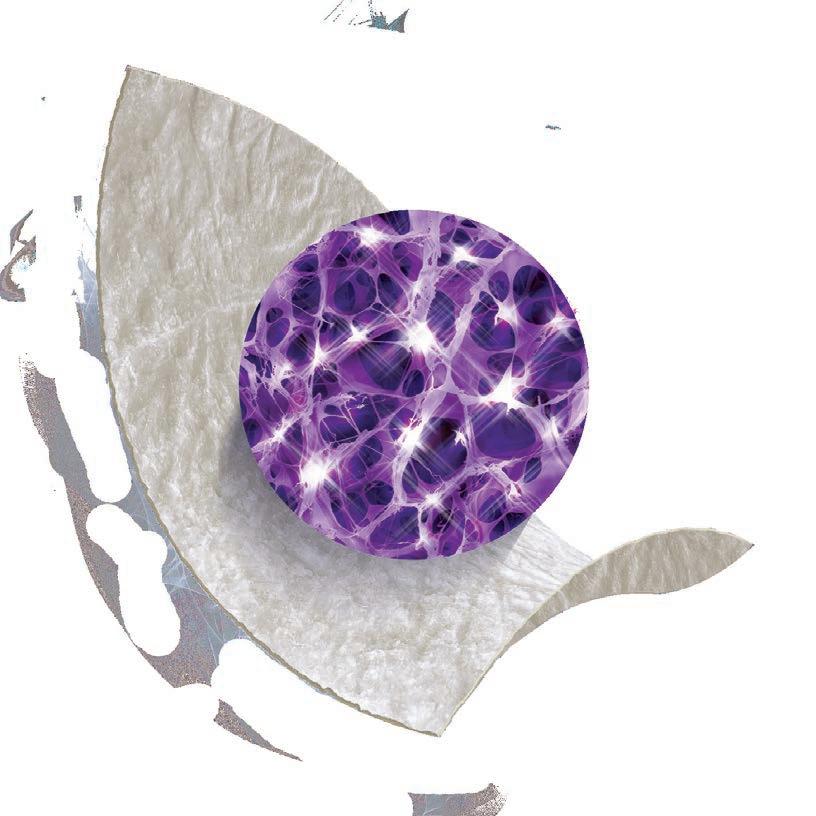
Puracol’s exclusive manufacturing process preserves the collagen’s natural, triple helix structure. The result? A dressing that more closely resembles our body’s native collagen.
This high quality collagen dressing jump starts wound healing and stays in contact with the wound bed for a longer period of time. 52
Collagen with a higher level of nativity53
This in vitro study shows that Puracol Plus and Puracol Plus Ag+ have the highest quantity of collagen and native collagen per dressing. This is achieved through our unique manufacturing process.
Evaluation of a Bovine 100% Native Collagen for the Treatment of Chronic Wounds54
After managing the wounds with a bovine-derived, 100% native, Type I collagen, 83% achieved wound closure within 90 days. (15 out of 18 patients)54
Puracol and Puracol Plus
• 100% collagen with a high degree of nativity53,55
• High gel integrity56
• Helps promote a natural wound environment conducive to wound healing
• Biodegradable
• Can be used in combination with negative pressure wound therapy (NPWT)57
Puracol Ag+ and Puracol Plus Ag+
In addition to all the benefits of Puracol Plus:
• Ionic silver provides antimicrobial barrier58,59
• Non-staining
Purocol Ultra Powder
• Maintains a high degree of nativity
• Increases the surface area in contact with the wound site
• Conforms to irregular shaped wound sites
83% achieved wound closure
Clinical highlight
Recommended Uses
• All wound depths
• All drainage levels
• As a primary dressing
Recommended Secondary Dressings
• Optifoam® Gentle
• Stratasorb® Composite
• Bordered gauze
• Gentac® Silicone Island Dressing
• Optifoam® Adhesive
Indications

• Pressure, venous, diabetic ulcers
• Partial- and full-thickness wounds
• Ulcers caused by mixed vascular etiologies
• Donor sites and other surface wounds
• Abrasions
• Traumatic wounds healing by secondary intention
• Dehisced surgical wounds
• Puracol Ag+, Puracol Plus Ag+ and Puracol Ultra ECM may be left in place for up to 7 days or replaced at the discretion of a healthcare professional
• Dressing change frequency will depend on amount of drainage
Contraindications
• Active vasculitis or patients with known sensitivity to collagen
• Puracol® Ag+ and Puracol® Plus Ag+ only: patients with known sensitivity to silver
• Third-degree burns
To order by each, add an “H” at the end of the item number. To order by box, add an “Z” at the end of the item number.
Puracol Item No. Description
MSC8511 1" x 1" (2.5 x 2.5 cm)
MSC8522 2" x 2" (5.1 x 5.1 cm)
MSC8544 4" x 4" (10.2 x 10.2 cm)
Puracol Plus Item No. Description
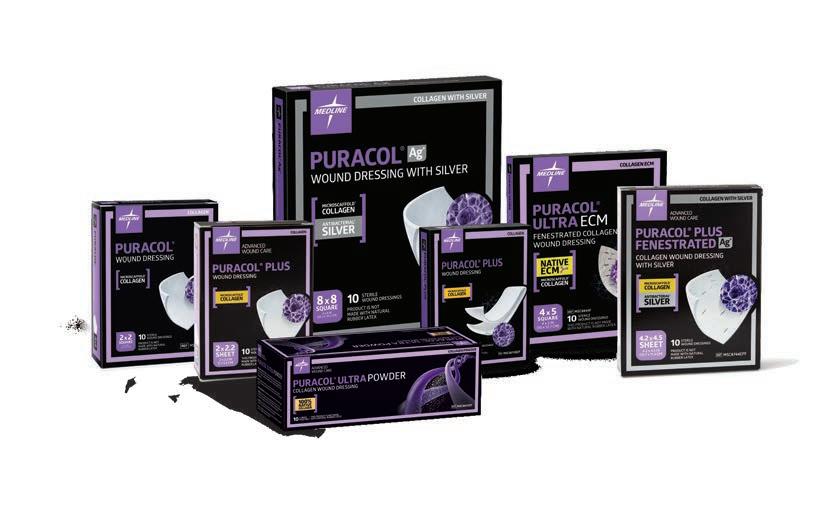
MSC8622EP* 2" x 2.25" (5.1 x 5.7 cm)
MSC8644EP* 4.25" x 4.5" (10.8 x 11.4 cm)
MSC861X8EP 1" x 8" (2.5 x 20.3 cm)
*Available with fenestrations. Add "F" at end of SKU.
Puracol Ultra Powder is the answer
10/bx, 50/cs
10/bx, 50/cs
10/bx, 50/cs
Puracol Ag+
Item No. Description HCPC Pkg.
MSC8422 2" x 2.25" (5.1 x 5.7 cm) A6021 10/bx, 50/cs
MSC8444 4.25" x 4.5" (10.8 x 11.4 cm) A6022 10/bx, 50/cs
Puracol Plus Ag+
Item No. Description HCPC Pkg.
MSC8722EP* 2" x 2.25" (5.1 x 5.7 cm) A6021 10/bx, 50/cs
MSC8744EP* 4.25" x 4.5" (10.8 x 11.4 cm) A6022 10/bx, 50/cs
MSC871X8EP 1" x 8" (2.5 x 20.3 cm) A6021 10/bx, 50/cs
*Available with fenestrations. Add "F" at end of SKU.
Puracol Ultra Powder
Item No. Description HCPC Pkg.
MSC8801EP 1 g A6010 10/bx, 100/cs
Puracol Ultra Powder offers the benefits of a collagen dressing with the flexibility of application. This product helps to protect the wound bed and provide a moist wound healing environment while supporting cellular activity and tissue growth.
Puracol Ultra ECM
Item No. Description HCPC Pkg.
MSC8822EP** 2" x 2" (5 x 5 cm) A6021 10/bx
MSC8845EP** 4" x 5" (10 x 12 cm) A6022 10/bx
**Available with fenestrations. Replace "EP" with "F" at end of SKU.
Use Puracol Ultra ECM
Puracol Ultra ECM, our most advanced collagen dressing, contains type I collagen and other important proteins. This dressing is designed to have a positive impact on the wound bed while retaining the native extracellular matrix structure.
The most robust collagen portfolio on the
Ideal for complex chronic wounds, burns and surgical sites
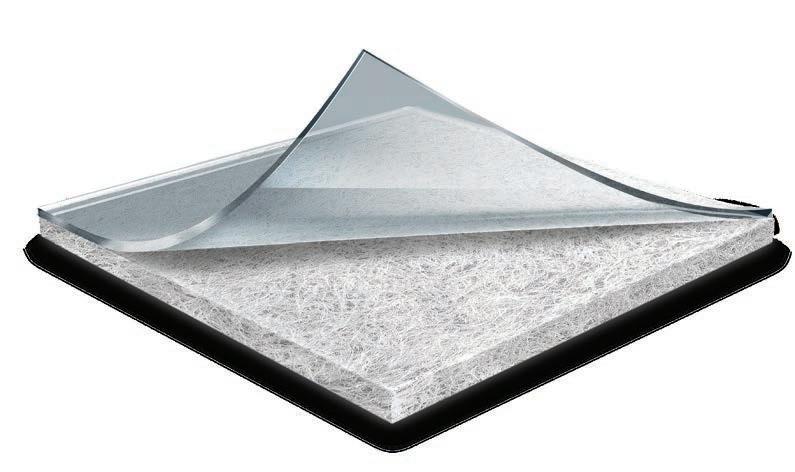
Optional, transparent semipermeable membrane protects the wound
Over time, HYAFF integrates with and is resorbed by the surrounding tissue
Hyalomatrix stimulates tissue regeneration61
After infection control and debridement,
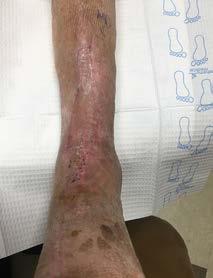
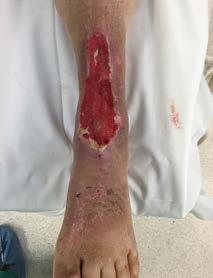
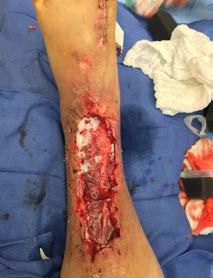
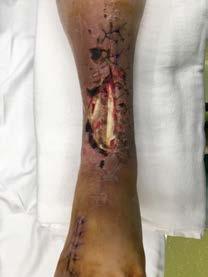
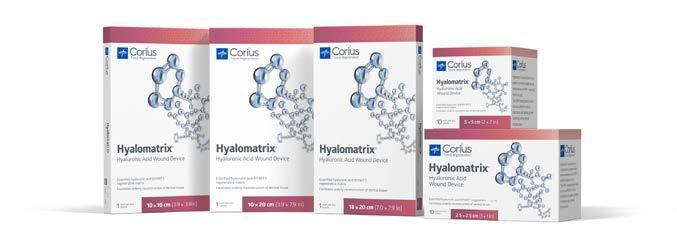
• Primary layer comprised entirely of HYAFF®, esterified hyaluronic acid
• Acts as a scaffold for cellular colonization and capillary growth
• Facilitates ordered reconstruction of the dermal tissue
• Optional semipermeable silicone membrane controls water vapor loss
Recommended Uses
• All wound depths
• All drainage levels
• Wounds with exposed structures like bone and/or tendon
• Primary layer
Recommended Secondary Dressings
• Versatel®
• Qwick™
• OptiLock®
• Sterile adhesive strips
Indications
• Pressure, venous, diabetic ulcers
• Partial- and full-thickness wounds
• Chronic vascular ulcers
• Second-degree burns
• Tunneled/undermined wounds
• Surgical wounds (donor sites/grafts, postMohs surgery, post-laser surgery, podiatric, wound dehiscence)
• Trauma wounds (abrasions, lacerations, second-degree burns, skin tears)
• Draining wounds
Change Frequency
• Removal of the silicone layer is recommended when the tissue underneath is healed, or ready for grafting, typically 14 to 21 days after application
Contraindications
• Individuals with a hypersensitivity to hyaluronan and/or its derivatives and silicone
Hyalomatrix can occasionally emit odor as it incorporates into the underlying tissue of the wound bed. To help reduce odor, irrigate with a high-performance wound cleanser like Prophase. To learn more, see pg. 63.
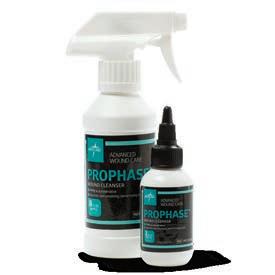
To order by each, add an “H” at the end of the item number.
Compression systems, skin protectants, cover dressings, tapes, and wound cleansers often play a critical role in the context of chronic wound care.
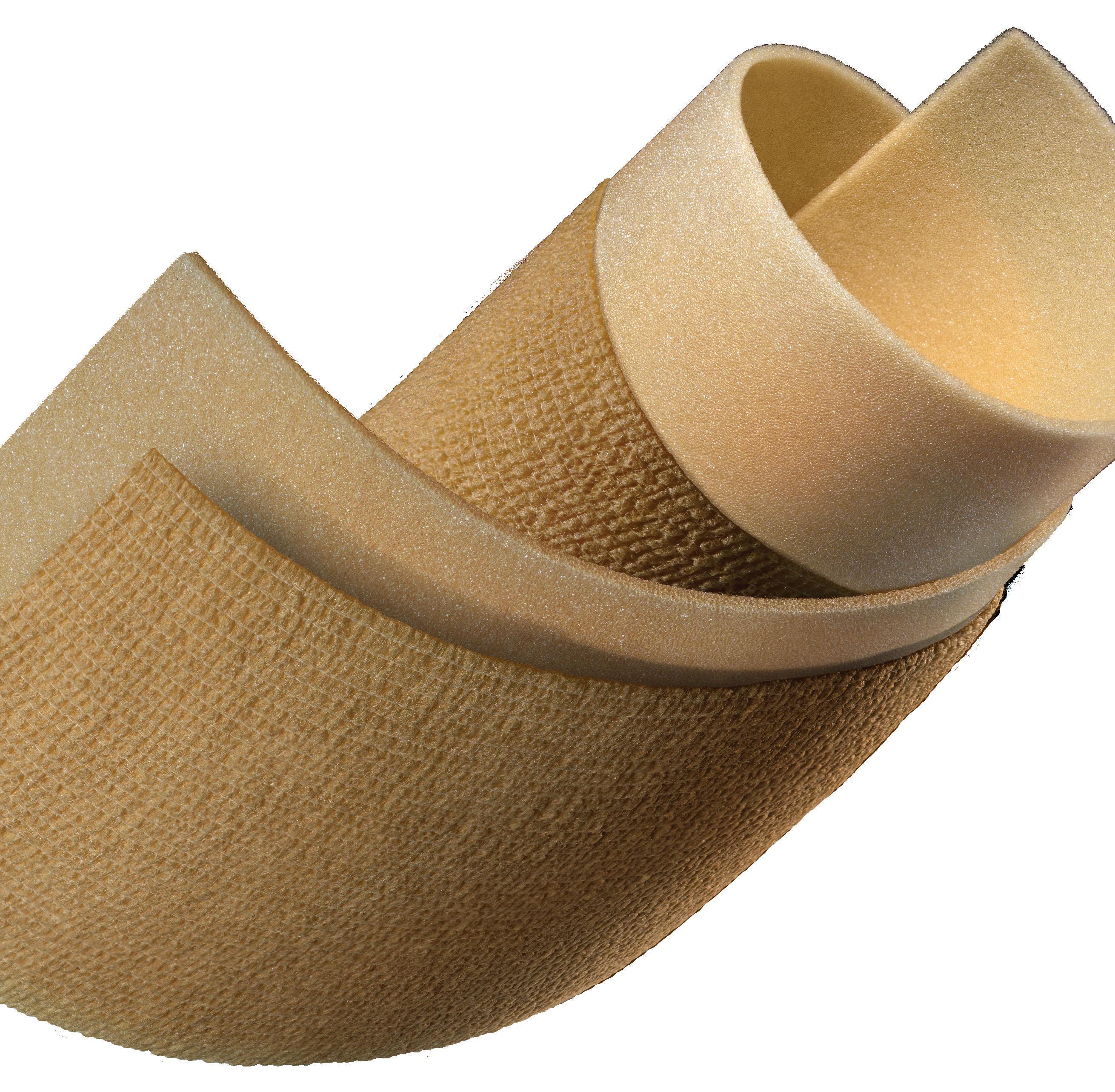

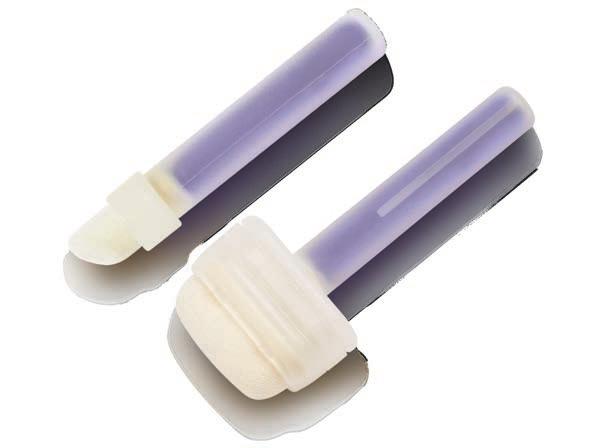
Marathon No-Sting Cyanoacrylate Skin Protectant provides a long-lasting, robust barrier that defends damaged or intact skin from breakdown caused by moisture, friction, shear and adhesive stripping.
Tested and proven
An independent study tested 12 subjects ages 60+ and compared how bare skin, skin with an application of Marathon, and skin with an application of Cavilon® resisted exposure to a corrosive fluid (synthetic urine).
Areas where Marathon was applied showed better resistance after each of the five urine and wash-off cycles compared to the areas where Cavilon or no product at all were applied.
Percent Dye Remaining (mean percentage) Marathon Liquid Skin Protectant 3M Cavilon No Sting Barrier No treatment barrier
90
70
No-sting 30
110 Immediately After Skin Barrier Application After Cycle 1 After Cycle 2 After Cycle 3 After Cycle 4 After Cycle 5
Clinical highlight
Long lasting 50
Percentage of retained dye after all five urine and wash-off cycles (mean percentage)62
Comparison Percentage Marathon 94% Cavilon 66% Skin with No Treatment 18%
Comparison P value Cavilon vs Marathon <0.05 Cavilon vs No Treatment >0.05 Marathon vs No Treatment <0.001
Clinical highlight
100% cyanoacrylate 5–10% cyanoacrylate
5x thicker and more robust
Reduces external force transmitted to tissue
A higher threshold of strain must be applied before tearing
Non-sticky film
Violet tint for easy visualization
Cyanoacrylate-based Barrier
Skin
A >20 µm layer of cyanoacrylate-based barrier can be clearly seen at x200 magnification. There are NO visible gaps between the skin and Marathon, since it bonded directly to the skin.63
Less adherent to skin
More external force is transmitted to tissue
A lower threshold of strain must be applied before tearing
Sticky film
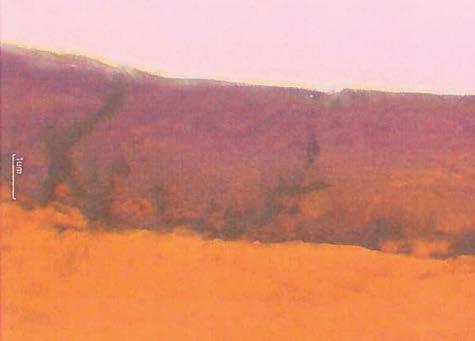
Transparent
Solvent-based barrier
Gap
Skin
The approximate <5 µm layer of a solventbased barrier at x200 magnification is seen in this image. The gap between the skin and the solvent-based barrier is visible.63
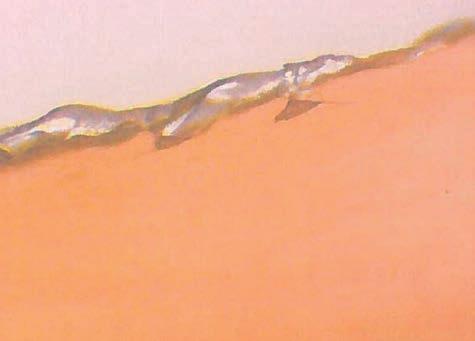

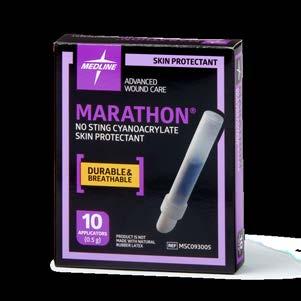

• Robust, flexible and long-lasting
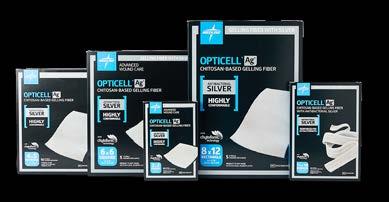
• Non-stinging; contains no solvents or activators
• Protects from the effects of friction and shear
• Protects from moisture- associated skin damage caused by urine, exudate, perspiration, and other body fluids
• Can be used on intact or damaged skin
• Fast drying
• Breathable
Recommended Uses
• Protection from moisture- associated skin damage
• Protection from friction and shear
• Protection from adhesive trauma
Indications
Protects intact or damaged skin from:
• Body fluids
• Moisture
• Friction and shear
• Adhesive stripping
Change Frequency
• Up to 3 days, reapply as needed
Contraindications
Do not apply directly to:
• Deep, open, bleeding, or chronic wounds
• Second- or third-degree burns
• Infected areas
Marathon provides robust, breathable protection which facilitates wound closure. Use Marathon in conjunction with Opticell Ag+ to treat or prevent maceration of the periwound. To learn more, see pg. 16.
On day 4 and day 5, subjects using Sureprep No-Sting experienced significantly less water loss than subjects using 3M Cavilon™ No-Sting.
• Protects from adhesive stripping65,66
• Safe for delicate skin67
• Outperformed 3M Cavilon® in controlled study64
• Fast drying 68
• Vapor permeable
• Creates a waterproof barrier on periwound skin
• Protection from friction and body fluids
• Transparent
Recommended Uses
• Protection from moisture associated skin damage
• Protection from corrosive fluids
• Protection from adhesive trauma
Indications
To be applied to intact or damaged skin in order to provide a primary barrier against:
• Bodily fluids
• Adhesive stripping
Change Frequency
• Up to 72 hours or with every dressing change
Contraindications
• On infected areas of skin
• Near the eyes
• As the only covering in situations that require additional dressing protection from bacterial contamination/ penetration, e.g., intravenous therapy cathether sites and full- or partial-thickness wounds
To order by each, add an “H” at the end of the item number. To order by box, add an “Z” at the end of the item number.
Sureprep No-Sting
Water-based no-sting skin protectant
Item No. Description HCPC Pkg.
MSC1505 No-Sting Protective Wipes, 1 mL A5120, A6250 50/bx, 500/cs
MSC1506 No-Sting Foam Wipes, 1 mL A5120, A6250 50/bx, 500/cs

MSC1510 No-Sting Wand Applicator, 1 mL A5120, A6250 25/bx, 125/cs
MSC1513 No-Sting Wand Applicator, 3 mL
Sureprep Rapid Dry

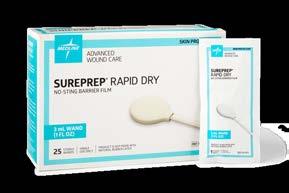
Fast-drying no-sting skin protectant Item No. Description
MSC1605 Rapid Dry Protective Wipes, 1 mL
A6250 25/bx, 100/cs
MSC1610 Rapid Dry Wand Applicator, 1 mL A5120, A6250 25/bx, 100/cs
MSC1613 Rapid Dry Wand Applicator, 3 mL A5120, A6250 25/bx, 100/cs
MSC1528 Rapid Dry Spray, 28 mL
Sureprep Wipes
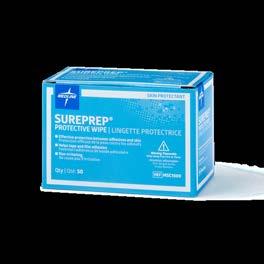
Skin protectant for intact skin; contains alcohol Item No. Description
A6250 12/cs
MSC1500 Skin Protective Wipes, 1 mL A5120, A6250 50/bx, 1,000/cs
MSC1500PK Skin Protective Wipes, 1 mL A5120, A6250 25/bx, 100/cs
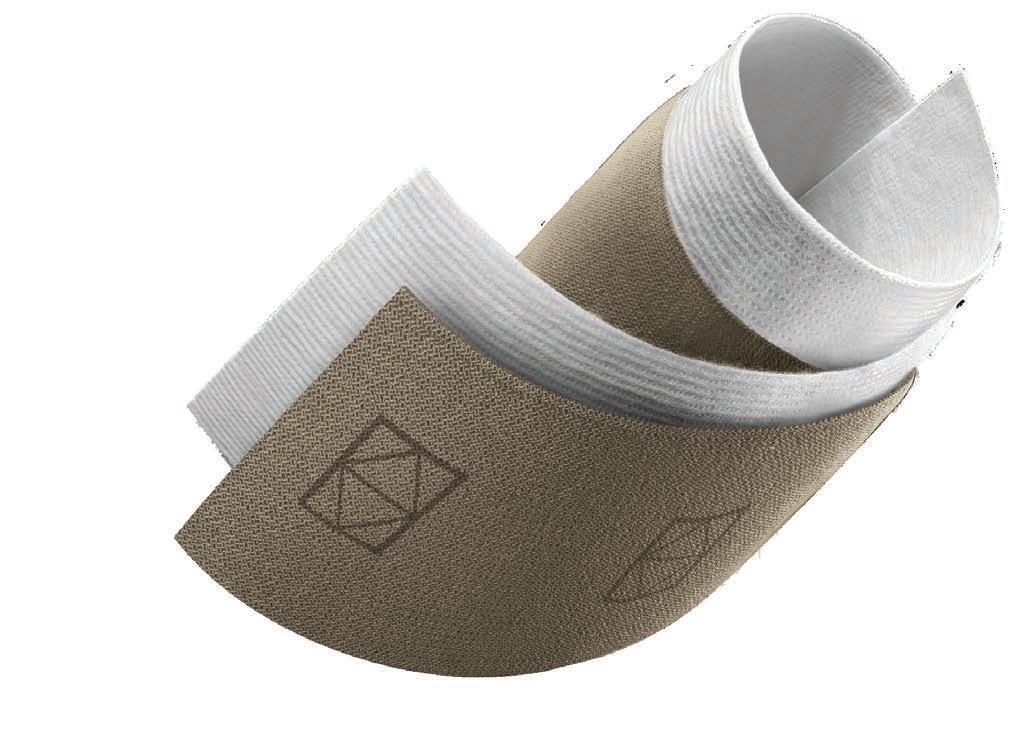
Venous leg ulcers are caused by an obstruction of the venous system or a defective venous valve. The condition begins with leg swelling and skin inflammation, which can lead to a venous ulcer. These wounds heal slowly and 70% return after healing. Compression therapy is a primary strategy to treat recurrence.69,70
AccuWrap is a two-layer system that delivers therapeutic compression to manage venous disease and associated edema for up to 7 days. AccuWrap is more comfortable and breathable under clothing, making it easier for patients to wear throughout treatment.
AccuWrap promotes patient education Research shows that when patients understand why they're receiving compression therapy, they are more likely to be compliant.70
Thinner than other leading brands71
Short stretch padding layer
100% polyester
Layer 2
Comfortable and breathable
Slight cohesive texture helps it stay in place
Woven short stretch compression layer
Sturdy, breathable woven fabric
Accuracy indicators confirm ideal compression level
• Low-profile system easily fits under clothing and footwear
• Absorbent padding bandage designed to conform to bony prominences
• Stocking included to ease movement
• Extra-long kit available for larger legs
• Easy and consistent application method
• AccuWrap and AccuWrap XL are designed to provide 30-40 mmHg of therapeutic compression.71
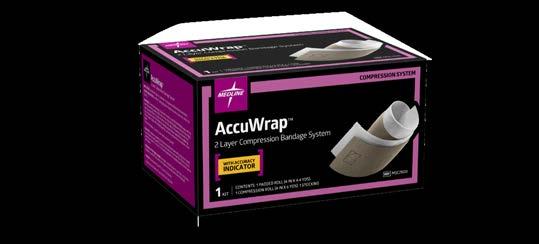
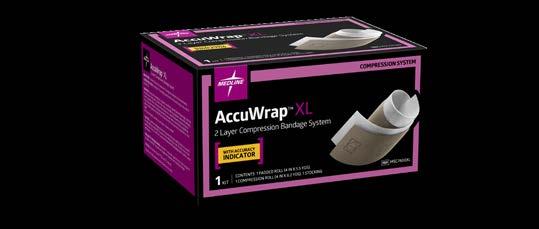
• AccuWrap Lite is designed to provide 20-30 mmHg of therapeutic compression.71
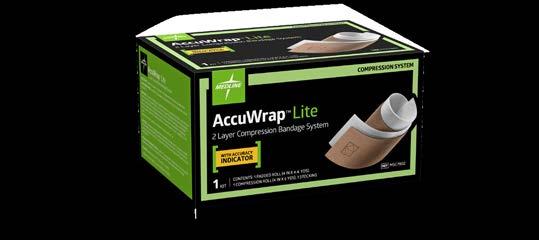
Recommended Uses
• Venous leg ulcers
Recommended Dressings
• Qwick™
• Opticell® Ag+
• OptiLock®
• IoPlex® Indications
• To deliver therapeutic compression to manage venous disease and associated edema
Change Frequency
• AccuWrap compression system may be left in place for up to 7 days
• Dressing change frequency will depend on amount of drainage
• AccuWrap and AccuWrap XL are contraindicated for a patient with severe arterial occlusive disease with an ABI of less than 0.8
• AccuWrap Lite is contraindicated for a patient with severe arterial occlusive disease with an ABI of less than 0.5
Layer 1
Foam padding layer
• Soft and conformable, which helps with comfort and promotes patient compliance
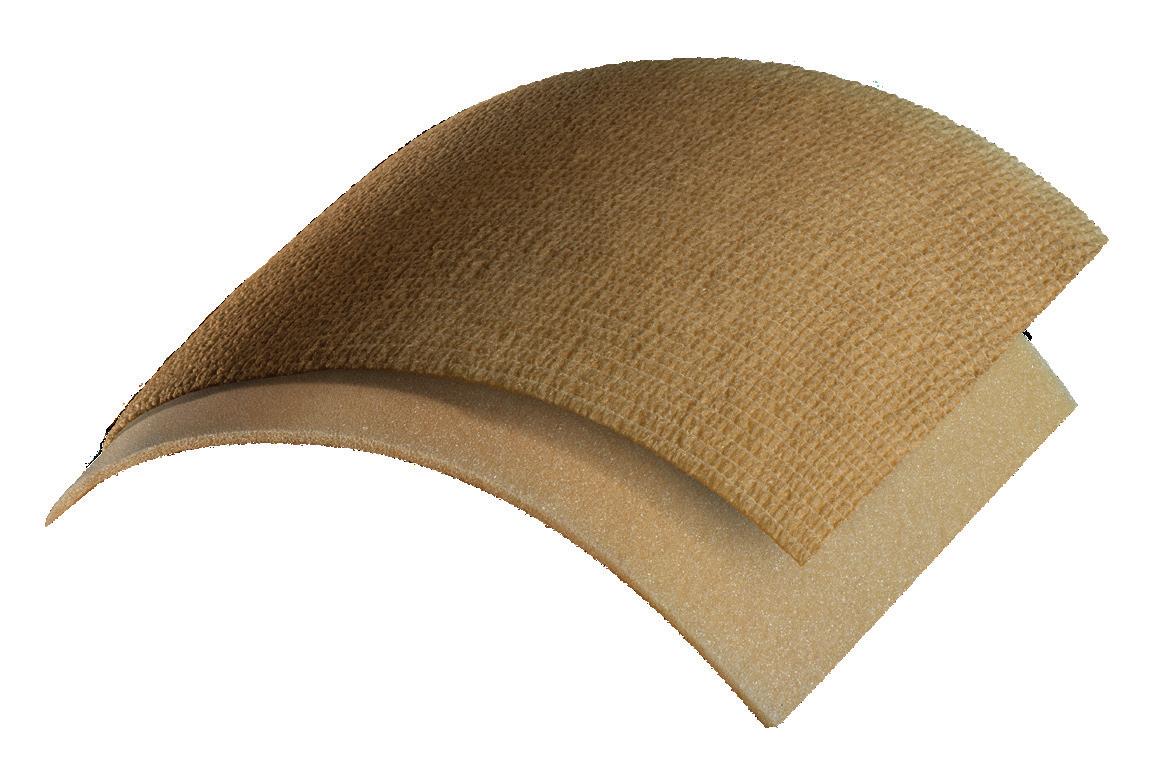
• Foam bandage absorbs moisture


• Flexible to allow ankle motion and to wrap the heel
• Can be torn by hand
• Low-profile system easily fits under clothing and footwear
• Stocking included to ease movement
• Both layers are easily torn by hand
• Patient information card included in every kit
• Extra-long kit available for larger legs
• Easy and consistent application method
Recommended Uses
• Venous leg ulcers
Recommended Dressings
• Qwick™
• Opticell Ag+®
• OptiLock®
• IoPlex®
Indications
• To deliver therapeutic compression to manage venous disease and associated edema
Change Frequency
• TwoFlex compression system may be left in place for up to 7 days
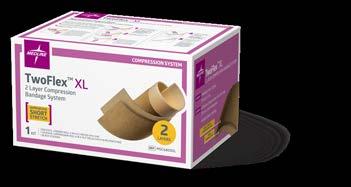
• Dressing change frequency will depend on amount of drainage
Contraindications
• TwoFlex and TwoFlex XL are contraindicated for a patient with severe arterial occlusive disease with an ABI of less than 0.8
• TwoFlex Lite is contraindicated for a patient with severe arterial occlusive disease with an ABI of less than 0.5
Layer 2
Cohesive compression layer
• Short stretch bandage
• Cohesive texture to help it stay in place
• Can be torn by hand
Item No. Description HCPC Pkg.
TwoFlex Kit
Padding: 4" x 3.4 yd.
MSC6800
(10 cm x 3.1 m) unstretched
Cohesive: 4" x 6.5 yd.
(10 cm x 5.9 m) unstretched
TwoFlex XL Kit
Padding: 4" x 5.5 yd.
8 kits/cs A6441 A6454
MSC6800XL
(10 cm x 5 m) unstretched
Cohesive: 4" x 7 yd.
(10 cm x 7.5 m) unstretched
TwoFlex Lite Kit
Padding: 4" x 3.4 yd.
A6441 A6454
8 kits/cs
MSC6802
(10 cm x 3.1 m) unstretched
Cohesive: 4" x 6.5 yd.
(10 cm x 5.9 m) unstretched
A6441 A6454
8 kits/cs
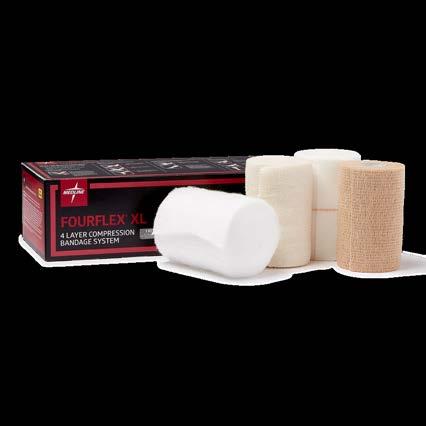
ABI Chart72
To determine the Ankle Brachial Index (ABI), divide the ankle systolic pressure by the brachial systolic pressure.
Ankle Pressure Brachial Pressure = ABI
Interpretation of the Ankle Brachial Index
Greater than 1.3 Abnormally high range (more studies are needed)
0.8 to 1.3 Normal range
0.50 to 0.80 Indicates mild to moderate arterial disease, compression should only be used under direct medical supervision
Below 0.50 Severe arterial insufficiency, compression is contraindicated
• Effective therapeutic compression
• Extended wear time
• Absorbs drainage
• Educational packaging
• FourFlex XL is 25% longer for larger legs
• FourFlex and FourFlex XL delivers 30–40 mmHg of compression72
• ThreeFlex delivers 20–30 mmHg of compression72
Recommended Uses
• Venous leg ulcers
Recommended
Dressings
• Qwick™
• Opticell Ag+®
• OptiLock®
• IoPlex®
Indications
• To deliver therapeutic compression to manage venous disease and associated edema
Change Frequency
• Multilayer compression bandages may be left in place for up to 7 days

• Dressing change frequency will depend on amount of drainage
Contraindications
• Patients with severe arterial disease
To order by kit, add an “H” at the end of the item number.
ThreeFlex Three-Layer Compression System
For lighter compression or for mixed etiology
Item No. Description
Padding: 4" x 4 yd. (10 cm x 3.6 m)
MSC4300
Light Conforming: 4" x 4.9 yd. (10 cm x 4.5 m) Stretched
Cohesive: 4" x 6.9 yd. (10 cm x 6.3 m) Stretched
FourFlex Four-Layer Compression System
A6441 A6443 A6454 8 kits/cs
For the management of chronic venous insufficiency
Item No. Description HCPC Pkg.
FourFlex Kit
Padding: 4" x 4 yd.
(10 cm x 3.6 m)
Light Conforming: 4" x 4.9 yd.
MSC4400
(10 cm x 4.5 m) Stretched
Compression: 4" x 9.5 yd.
(10 cm x 8.7 m) Stretched
Cohesive: 4" x 6.9 yd.
(10 cm x 6.3 m) Stretched
FourFlex XL Kit
Padding: 4" x 5 yd.
(10 cm x 4.6 m), 25% Longer
Conforming: 4" x 6.3 yd.
(10 cm x 5.7 m) Stretched, 29% Longer
MSC4400XL
Compression: 4" x 12.3 yd.
(10 cm x 11.2 m) Stretched, 29% Longer
Cohesive: 4" x 8.9 yd.
(10 cm x 8.1 m) Stretched, 29% Longer
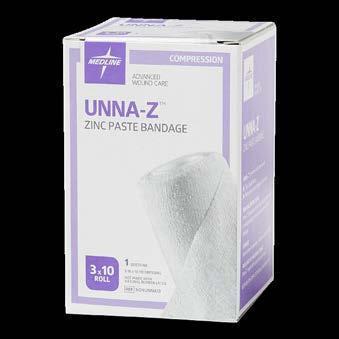
About Unna-Z
• Maintains a moist and soothing skin environment
• Provides semi-rigid support for conditions requiring mild compression
• Impregnated with zinc oxide paste (with or without calamine)
• Improved knitted design
• Inner plastic core for easier application
• Unna-Z Stretch provides greater elasticity

Recommended Uses
• Venous leg ulcers
Recommended Dressings
• Qwick™
• Opticell Ag+®
• OptiLock®
• IoPlex®
Recommended Covering Wrap
• Medline cohesive wraps
• Bulkee® Gauze Wrap
Indications
• Venous leg ulcers
Change Frequency
• Unna-Z may be left in place for up to 7 days, depending on drainage
Contraindications
• Patients with a known sensitivity to components (zinc and/or calamine)
To order by each, add an “H” at the end of the item number.
Zinc impregnated gauze bandage
Elastic zinc impregnated bandage
3" x 10 yd Stretched (7.6 cm x 9.1 m), Elastic, with Calamine
4" x 10 yd Stretched (10.2 cm x 9.1 m), Elastic, with Calamine
• Provides excellent support for joints
• Easy to apply and reapply
• Wide range of applications
• Good for securing dressings
• Can be used as mild compression when doubled
• Also comes in latex-free version
Recommended Uses
• Dressing retention
• Light compression
Recommended Dressings
• Qwick
• Opticell Ag+®
• OptiLock®
• IoPlex®
Indications
• Edema
• Treatment of chronic venous insufficiency
• Dislocations
• Sprains
• As a retention dressing
• Medigrip may be left in place for up to 7 days
• Dressing change frequency will depend on amount of drainage
Item numbers with "LF" are not made with natural rubber latex (Medigrip LF).
Medigrip Tubular Bandage 11 yd. (10 m) long
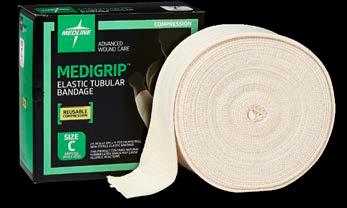
Limb Measurement* Compression Level for Double Layer
Medium (10-20 mmHg) High (20-30 mmHg)
5"–6" (13–15 cm) B - -
6"–7" (15–18 cm) B - -
7"–8" (18–20 cm) C B -
8"–9" (20–23 cm) D B -
9"–10" (23–25 cm) E C -
10"–12" (25–30 cm) E D -
12"–15" (30–38 cm) F E B
15"–18" (38–46 cm) G E C
18"–23" (46–58 cm) G E D
23"–28" (58–71 cm) J F E
28"–38" (71–97 cm) K G -
Low (5-10 mmHg) Medium (10-20 mmHg) High (20-30 mmHg)
5"–5.5" (13–14 cm) A - -
5.5"–6" (14–15 cm) B A -
6"–7" (15–18 cm) C B A
7"–8" (18–20 cm) D B A
8"–9" (20–23 cm) E C B
9"–10" (23–25 cm) F D B
10"–12" (25–30 cm) F E C
12"–15" (30–38 cm) G F D
15"–18" (38–46 cm) G F E
18"–23" (46–58 cm) J G F
23"–28" (58–71 cm) J G -
28"–38" (71–97 cm) K J -
*For full arm coverage, measure the largest part of the forearm. For full leg or below the knee coverage, measure the widest point of the calf. For the hand, measure around metacarpophalangeal joint.
Chronic venous insufficiency (CVI) occurs when venous walls or valves don't work effectively and have difficulty moving blood toward the heart. CVI causes the blood to pool in the leg, leading to increased pressure and swelling. This additional pressure can cause fluid and blood to leak out of veins, which can lead to skin staining and venous ulcers.
• Compression levels of 20–30, 30–40 and 40–50 mmHg
• Liner sock has graduated compression throughout the foot and ankle
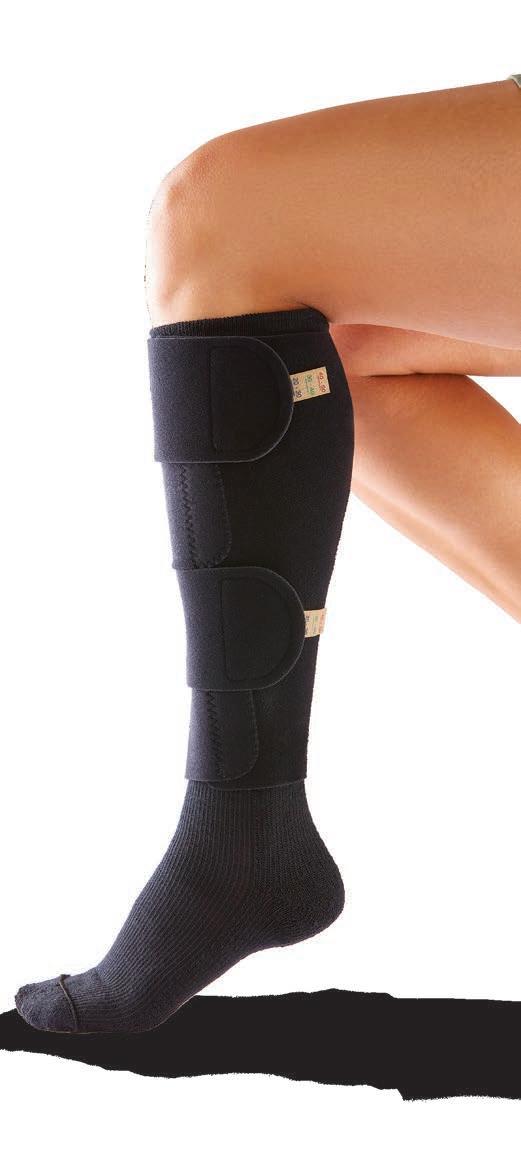
• Specially designed fabric wicks away moisture to help avoid skin damage
• Each pack includes 2 reusable socks—one to wash and one to wear—for up to 6 months
Recommended Uses
• Venous leg ulcers
Recommended Dressings
• Qwick™
• Opticell Ag+®
• OptiLock®
• IoPlex®
Indications
• Chronic venous insufficiency (CVI)
• Edema
• Venous stasis ulcers
• Lymphedema
Change Frequency
• COMPRECARES compression system should be removed once every 12 hours
• Dressing change frequency will depend on amount of drainage
Contraindications
• Acute-untreated cellulitis, or other major skin infections
• Acute-untreated Deep Vein Thrombosis (DVT)
• Untreated kidney disease
• Severe Peripheral Arterial Disease (PAD), or an anklebrachial pressure index (ABI) less than 0.5
• Untreated spectic phlebitis
• Acute, decompensated CHF or Myocardial Infarction (MI)
Take the guesswork out of achieving proper compression with COMPRECARES Compression Garments with ACCUTAB system.
• Compression levels of 20–30, 30–40 and 40–50 mmHg
• Liner sock has 10–15 mmHg of compression
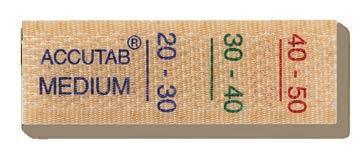

• Specially designed fabric wicks away moisture to help avoid skin damage
• Each pack includes 2 reusable socks—one to wash and one to wear—for up to 6 months
Roll back straps for easy application
Contoured calf for a superior fit
Front stretch panel secures garment in place
Double-stitched to ensure durability
Soft, conformable Breathe-O-Prene® fabric
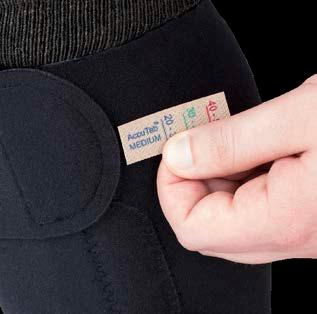 Easy to apply and adjust for increased patient compliance
Quickly identify the correct pressure range
Easy to apply and adjust for increased patient compliance
Quickly identify the correct pressure range
1. Using a measuring tape with centimeters, measure the leg height from the center of outer ankle bone (point Ø) to the fibular head, as shown on the illustration. Record this measurement in the space provided for point G.
2. Measure around each part of the leg at the letters shown in the illustration:
C1—30 cm above point Ø
C—25 cm above point Ø
B—15 cm above point Ø
A—5 cm above point Ø
3. Compare your measurements to the chart and select the size that matches. If measurements C1, C, B and A align to multiple sizes, select the smaller garment and use a strap extender for the larger areas of the leg.
Each package includes a compression garment, two transition liner socks and a set of AccuTabs.
* Note: Use HCPCS A6545** for all garments listed.
** Use modifier AW to indicate a surgical dressing is being used.
Additional replacement transition liner socks are also available separately. Each package contains two socks.
Compression garments are available in 10 sizes for maximum therapeutic benefits.
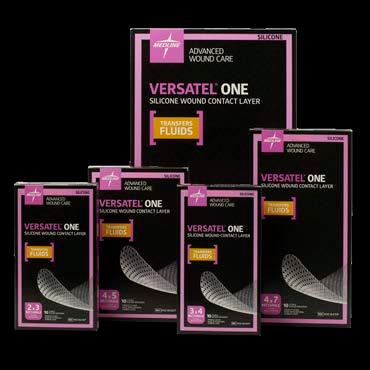
Reduce trauma from secondary dressing wound adherence
• Silicone-based atraumatic adhesive
• Flexible and pliable to conform to body contours and improve comfort
• Versatel One features one-sided silicone contact for easy handling
• Reduces potential trauma from secondary dressing wound adherence
• Minimizes discomfort during removal
• Channels allow fluid to easily transfer to an absorbent dressing
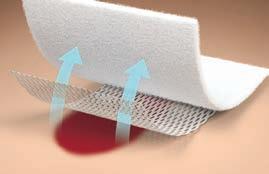
• Translucent for easy wound visualization
Recommended Uses
• To prevent secondary dressing adhesion to the wound
Recommended
Secondary Dressings
• OptiLock®
• Qwick
• Maxorb® II
Indications
• Dry to heavily draining abrasions
• Partial- and fullthickness wounds
• Venous ulcers or pressure injuries
• Skin tears
• First- and seconddegree burns
• Blisters, cuts and lacerations
• Surgical and trauma wounds
Change Frequency
• Versatel may be left in place for up to 7 days
• Dressing change frequency will depend on amount of drainage
• Third-degree burns
• Individuals with a known sensitivity to silicone
• Not for surgical implantation
Clinical highlight
A fluid transfer lab study found that Versatel One has a significantly higher average flow rate than that of the leading competitor.
Versatel is designed to allow wound fluid to easily transfer into a secondary dressing.73
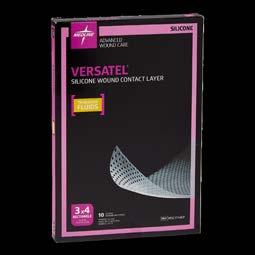
To order by each, add an “H” at the end of the item number. To order by box, add an “Z” at the end of the item number.
Versatel One
One-sided silicone contact layer dressing for easier handling Item No.
Pkg. MSC1823EP 2" x 3" (5.1 x 7.6 cm)
MSC1834EP 3" x 4" (7.6 x 10.2 cm)
MSC1845EP 4" x 5" (10.2 x 12.7 cm)
MSC1847EP 4" x 7" (10.2 x 17.8 cm)
MSC18812EP 8" x 12" (20.3 x 30.5 cm)
Versatel
Two-sided silicone contact layer dressing
10/bx, 50/cs
10/bx, 50/cs
10/bx, 50/cs
10/bx, 50/cs
A6208 5/bx, 25/cs
Item No. Description HCPC Pkg.
MSC1723EP 2" x 3" (5.1 x 7.6 cm)
MSC1734EP 3" x 4" (7.6 x 10.2 cm)
MSC1747EP 4" x 7" (10.2 x 17.8 cm)
MSC17812EP 8" x 12" (20.3 x 30.5 cm)
A6206 10/bx, 50/cs
A6206 10/bx, 50/cs
A6207 10/bx, 50/cs
A6208 5/bx, 25/cs
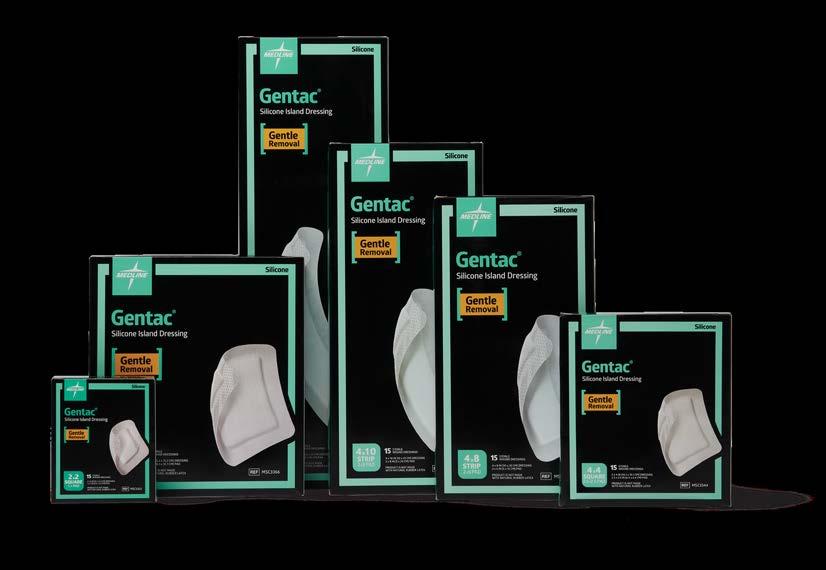
Easy on and off
Gentac Silicone Island Dressings
• Silicone adhesive for gentle removal
• Water-resistant backing
• Low profile design increases flexibility and comfort
• Can be lifted and reapplied
Recommended Uses
• All wound depths
• Minimal drainage levels
• Primary dressing
• Secondary dressing
Indications
• Partial- and fullthickness wounds
• Surgical and drain sites
• Can be left in place for up to 7 days
• Change the dressing as indicated by the amount of drainage or as frequently as the primary dressing indicates
• Third-degree burns
• Patients with a known sensitivity to components of the dressing
To order by each, add an “H” at the end of the item number. To order by box, add an “Z” at the end of the item number.
Gentac Silicone Island Dressings
Item No. Description
MSC3322 2" x 2" (5.1 x 5.1 cm);
Pad: 1" x 1" (2.5 x 2.5 cm) A6219 150/cs
MSC3344 3" x 4" (10.2 x 10.2 cm);
Pad: 2.5" x 2.5" (6.4 x 6.4 cm)
MSC3366 6" x 6" (15.2 x 15.2 cm);
Pad: 4.5" x 4.5" (11.4 x 11.4 cm)
MSC3348 4" x 8" (10.2 x 20.3 cm);
Pad: 2" x 6" (5.1 x 15.2 cm)
MSC33410 4" x 10" (10.2 x 25.4 cm);
Pad: 2" x 8" (5.1 x 20.3 cm)
MSC33414 4" x 14" (10.2 x 35.6 cm);
Pad: 2" x 12" (5.1 x 30.5 cm)
A6219 150/cs
A6220 150/cs
A6219 150/cs
A6219 150/cs
A6220 150/cs
• Non-adherent deluxe soaker pad
• Non-woven adhesive border
• Waterproof backing (Stratasorb)
• Ideal for incision sites
Recommended Uses
• All wound depths
• All drainage levels
• Primary dressing
• Secondary dressing
Indications
• Pressure injuries
• Partial- and full-thickness wounds
• Incision sites
Change Frequency
• Can be left in place for up to 7 days
• Change the dressing as indicated by the amount of drainage or as frequently as the primary dressing indicates
Contraindications
• Third-degree burns
• Patients with a known sensitivity to components of the dressing
To order by each, add an “H” at the end of the item number. To order by box, add an “Z” at the end of the item number.
Stratasorb® Composite Cover Dressings
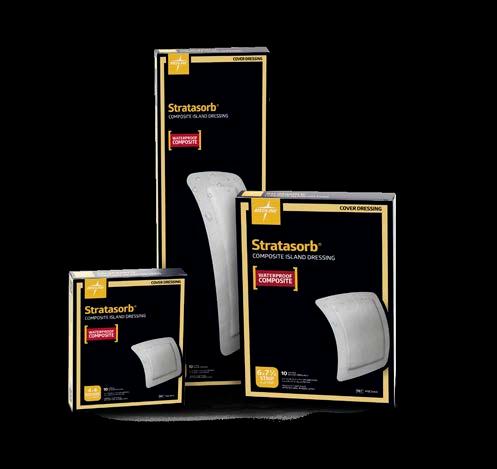
Waterproof, convenient secondary dressing
Item No. Description HCPC Pkg.
MSC3044 4" x 4" (10.2 x 10.2 cm);
Pad: 2.5" x 2" (6.4 x 5.1 cm) A6203 10/bx, 100/cs
MSC3066 6" x 6" (15.2 x 15.2 cm);
Pad: 4" x 4" (10.2 x 10.2 cm)
MSC3068 6" x 7.5" (15.2 x 19.1 cm);
A6203 10/bx, 100/cs
Pad: 4" x 6" (10.2 x 15.2 cm) A6204 10/bx, 100/cs
MSC30410 4" x 10" (10.2 x 25.4 cm);
Pad: 2" x 8" (5.1 x 20.3 cm) A6203 10/bx, 100/cs
MSC30414 4" x 14" (10.2 x 35.6 cm);
Pad: 2" x 12" (5.1 x 30.5 cm)
Bordered Gauze Cover Dressings
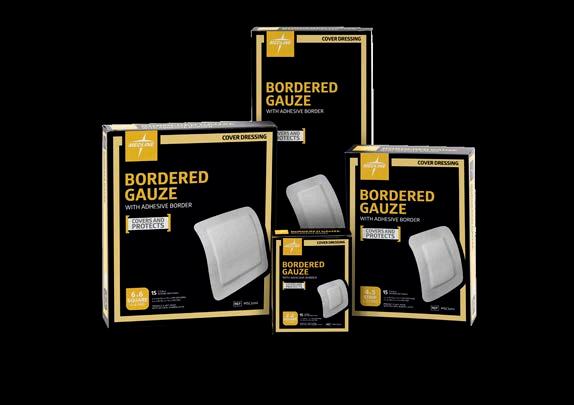
A6204 10/bx, 100/cs
Water-resistant, easy-to-use secondary dressing
MSC3222 2" x 2" (5.1 x 5.1 cm),
Pad: 1" x 1" (2.5 x 2.5 cm)
MSC3244 4" x 4" (10.2 x 10.2 cm),
Pad: 2.5" x 2.5" (6.4 x 6.4 cm)
MSC3245 4" x 5" (10.2 x 12.7 cm),
Pad: 2" x 2.5" (5.1 x 6.4 cm)
MSC3248 4" x 8" (10.2 x 20.3 cm),
Pad: 2" x 6" (5.1 x 15.2 cm)
MSC3266 6" x 6" (15.2 x 15.2 cm),
Pad: 4" x 4" (10.2 x 10.2 cm)
MSC32410 4" x 10" (10.2 x 25.4 cm),
Pad: 2" x 8" (5.1 x 20.3 cm)
MSC32414 4" x 14" (10.2 x 35.6 cm),
Pad: 2" x 12" (5.1 x 30.5 cm)
MSC3236 3" x 6" (7.6 x 15.2 cm),
Pad: 1" x 4" (2.5 x 10.2 cm)
A6219 15/bx, 150/cs
A6219 15/bx, 150/cs
A6219 15/bx, 150/cs
A6219 15/bx, 150/cs
A6219 15/bx, 150/cs
A6219 15/bx, 150/cs
A6220 15/bx, 150/cs
N/A 15/bx, 150/cs
MedFix
• MedFix tapes are water resistant

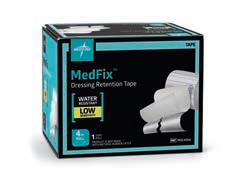
• MedFix has a printed s-curve release liner
• MedFix EZ is linerless and perforated
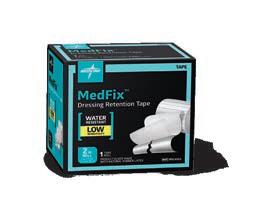
Gentac
• Gentac is transparent
• Gentac uses gentle and repositionable silicone adhesive
• Gentac tape is waterproof
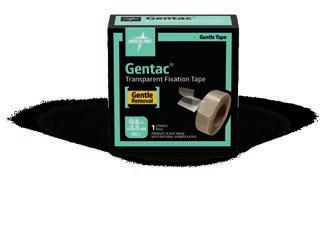
Gentac EZ
• Gentac EZ uses gentle and repositionable silicone adhesive
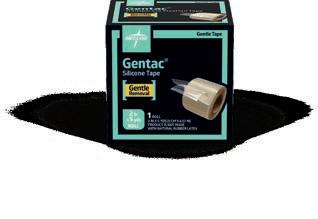
• Gentac EZ is easily torn to size
Pinc
• Pinc utilizes a zinc oxide adhesive
• Pinc tape is waterproof and adheres well even in moist conditions
Recommended Use
• Dressing and device retention
Indications
• To secure primary dressings
• To secure gastrostomy tubes and other feeding tubes
Change Frequency
• Dressing change frequency will depend on the primary dressing and amount of drainage
Contraindications
• Contraindicated as a primary dressing
Medfix Tapes
Non-woven tapes with S-curve liner
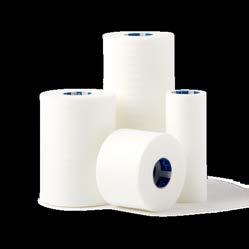
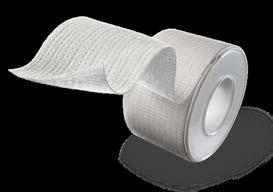
Medfix EZ Tapes
Linerless non-woven tapes with 2" perforations
To order by each, add an “H” at the end of the item number.
Gentac Silicone Tapes
Transparent silicone tapes
To order by each, add an
Gentac EZ Silicone Tape
Silicone tapes
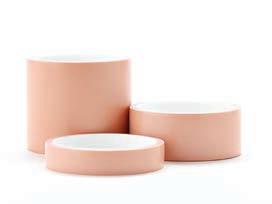
To order by each, add "PK" at the end of MSC1411 and MSC1421, and add an "H" at the end of MSC1415 and MSC1425.
Pinc™ Tapes
Zinc oxide adhesive tapes
To order by each, remove the “CS” at the end of the item number.
• Adjustable trigger, PSI of 8.6 at 3"
• Within AHCPR guidelines
• MicroKlenz is antimicrobial
• Prophase contains PHMB as a preservative and has a low pH formulation

Recommended Uses
• Cleansing all types of wounds
Indications
To clean a wide variety of wounds including:
• Pressure injuries
• Partial- and full-thickness wounds
• Infected and non-infected wounds
Change Frequency
• With every dressing change
Contraindications
• Patients with a known sensitivity to ingredients in the wound cleanser
To order by each, add an “H” at the end of the item number.
kintegrity® Wound Cleansers
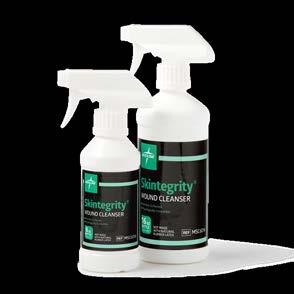
Surfactant-based wound cleanser with spray and stream nozzle
Item No. Description Pkg.
MSC6008 Spray Bottle: 8-oz. (236 mL) 6/cs
MSC6016 Spray Bottle: 16-oz. (473 mL) 6/cs
MSC6001 Squeeze Bottle: 1-oz. (30 mL) 15/bx
Prophase® Wound Cleansers PHMB preserved wound cleanser
Item No. Description Pkg.
MSC8008 Spray Bottle: 8-oz. (236 mL) 6/cs
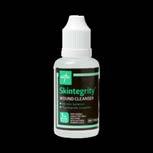
MSC8002 Squeeze Bottle: 2-oz. (59 mL) 12/cs
MicroKlenz™ First Aid Antiseptic Antiseptic BZK based wound cleanser
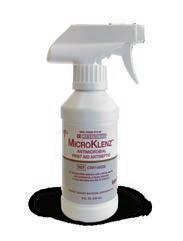
Item No. Description Pkg.
CRR108008 Spray Bottle: 8-oz. (236 mL) 6/cs
CarraKlenz™ Wound Cleansers
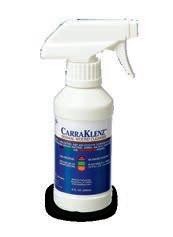
Surfactant-based wound cleanser with spray and stream nozzle
Item No. Description Pkg.
CRR102060 Pump: 6-oz. (177 mL) 12/cs
CRR102062 Spray Bottle: 8-oz. (236 mL) 6/cs
CRR102160 Spray Bottle: 16-oz. (473 mL) 6/cs
This intuitively-designed dressing change system combines all the products and instructions to guide the caregiver step-by-step—from dressing removal to application of the new dressing.
• Intuitively guides clinicians left-toright through dressing changes
• Creates a sterile work area and organizes all components to help prevent contamination at every step
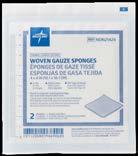

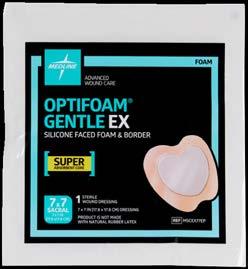

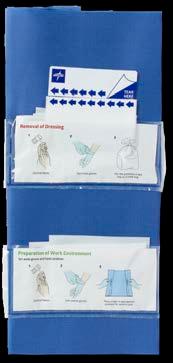
• Promotes patient safety, consistent practice and improved outcomes
Item No. Description Pkg.

MSCKIT01 Wound Care Starter Kit 20/cs



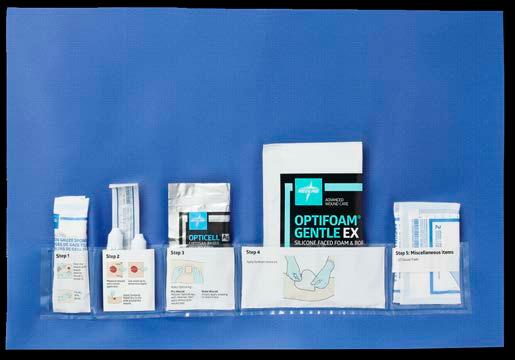
MSCKIT01H Wound Care Starter Kit 1 ea
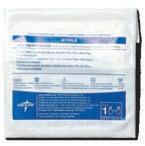


Kit
contents:
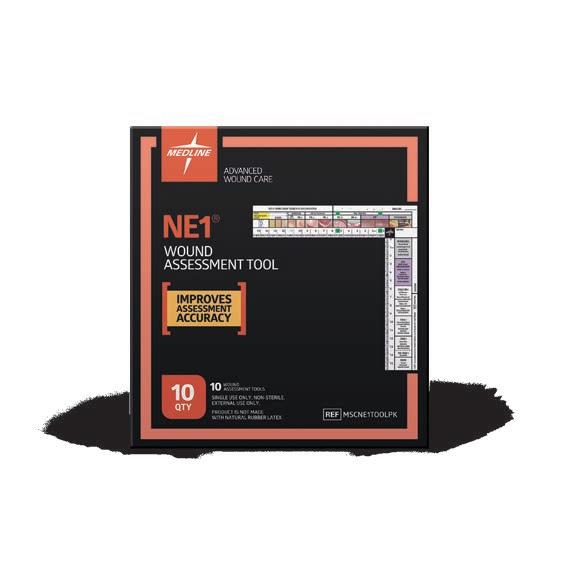
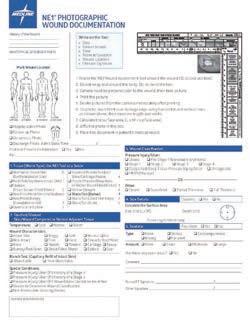

• One time use tool to assist with wound evaluation upon admission, throughout healing and at discharge
• Easy-to-use color-matching technique
• Reduces errors and promotes accurate wound assessment
• Standardizes wound documentation
• Free online education
The study showed a statistically significant improvement in wound assessment. Overall, the clinicians more than doubled their accuracy with the help of the NE1 Wound Assessment Tool.
This comprehensive documentation form simplifies the assessment and documentation process. A PDF can be found at

An important number to remember is 1-888-701-SKIN (7546) because it reaches our Skin Health Hotline, managed by board-certified wound care nurses. The nurses are available to answer questions about product usage such as application and appropriateness of a dressing for a particular wound condition.
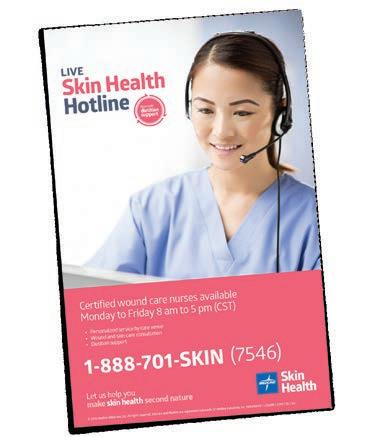
The Skin Health Hotline is staffed Monday through Friday from 8 am to 5 pm Central Time.



Receiving support from one of Medline’s 80+ wound care product specialists has never been easier. The wound care product specialists are devoted to supplying you with appropriate wound care products, services and educational support. This team is highly trained and available to deliver on-site, face-to-face in-servicing for your staff.
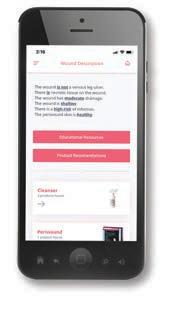
Convenient mobile tool gives your staff customized product and education recommendations, including easy access to our Skin Health hotline. Easily integrates with your facility’s formulary for increased efficiency and standardization.
Medline’s website is another way to get up-to-date product information. You will find application videos for all of our advanced wound care products at www.medline.com/awcvideos. The interactive product selector can also help you choose the best product based upon the wound conditions.
Practical guidelines are designed as a starting point for your staff, as an approach to holistic skin health management. This systematic approach is a proven roadmap for better care in the home.
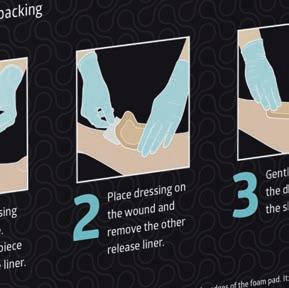
Many nurses find themselves in situations on a daily basis where valuable time is wasted searching for the right dressing. Often the wrong dressing is used or the dressing is not used properly.
By listening to you, Medline has found a way to improve this process and ensure that nurses have the information they need. It is called Educational Packaging. The package focuses on patient safety and correct product application. Each package serves as a 2-Minute Course on Wound Care™.
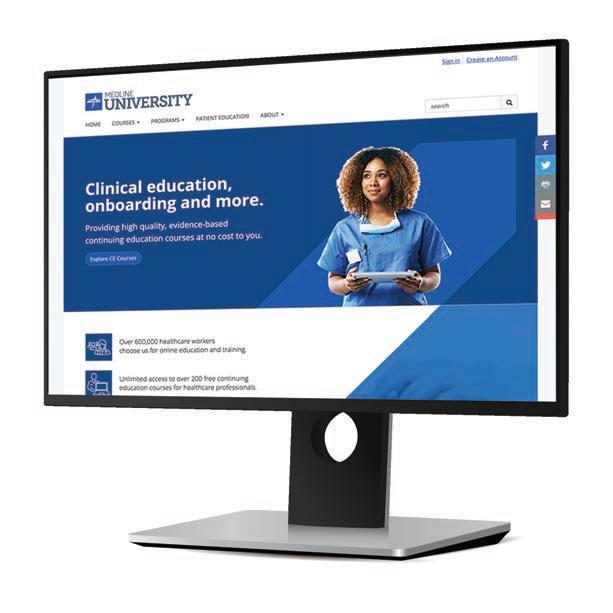
Get instant online access to exclusive clinical education courses covering skin and wound care, including:
• 100+ courses and 20 CEs to reinforce best practices
• Skin Health resource center: articles, webinars and patient education
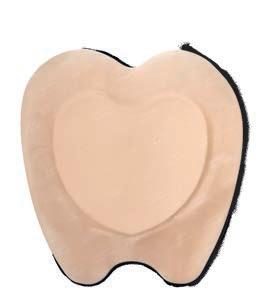
• Clinical guides for caregivers, patients and HME staff to enhance care quality
• Product guides with over 40 competency assessments to ensure proper use of our products
Visit www.medlineuniversity.com for more information.
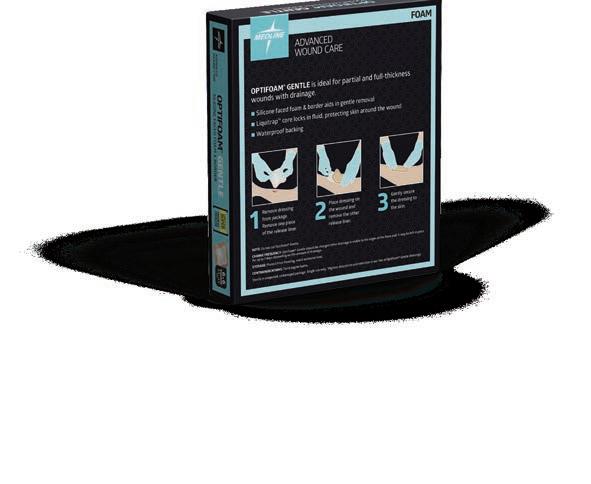
From prevention to treatment, empower staff to confidently care for skin
Research shows—many caregivers feel they don’t have the tools or training they need to provide proper skin and wound care. Make it easier for staff to assess, treat and monitor wounds, and deliver evidence-based care to patients, with our Skin Health digital platform.
best practices to keep staff up to date, including detailed product information and usage videos.

Simplify skin and wound care and help patients heal faster—with the NE1 Wound Management System.
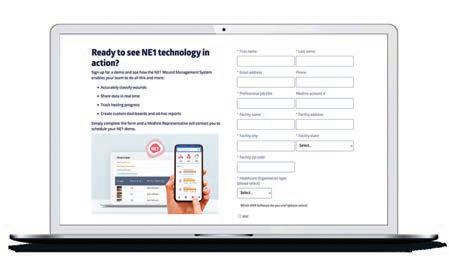
• Significantly improve wound assessment accuracy
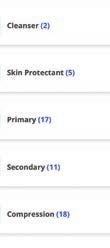
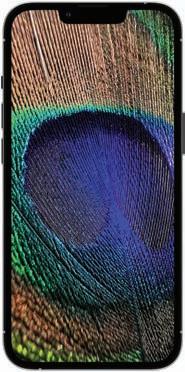
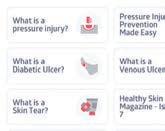


• Accurately measure wounds and track healing progress over time
• Seamlessly coordinate care with insights from remote experts
• Manage workflows to fit documentation and assessment needs
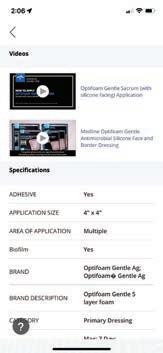

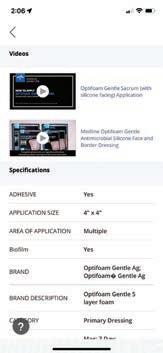
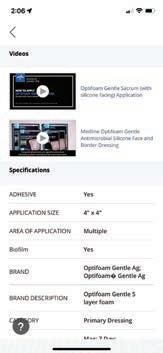
• Analyze outcome data to continuously improve treatment and training protocols
Download the app to learn about skin and wound care, repositioning and offloading, nutrition and more— all from your smartphone. See
1. Yang Q, Larose C, Porta AD, Della Porta AC, Schultz GS, Gibson DJ. A surfactant-based wound dressing can reduce bacterial biofilms in a porcine skin explant model. International Wound Journal. 2017;14(2):408-413.
2. Data on file. Caroline Fife, MD, FAAFP, CWS. Medline owns the rights to the photos in this case study.
3. Data on file.
4. Cimolai, N. Sweet success? Honey as a topical wound dressing BCMJ. Vol. 49, No. 2, March 2007: 64-67.
5. Green AE. Wound healing properties of honey. Br J Surg 1988; 75(12): 1278.
6. Molan P, Debridement of Wounds with Honey, J Wound Technology 2009: 12-17.
7. Tovey FI. Honey and healing. J R Soc Med 1991; 84(7): 447.
8. Schultz, G; Gibson, D. “The Impact of Silver Impregnated Dressings and Wound Cleansers on the Osmotic Strength of 100% Manuka Honey Gel Dressing”. Department of Obstetrics and Gynecology; Institute of Wound Research; University of Florida; Gainesville, FL. 2013.
9. At tinger C and Wolcott R. Clinically addressing biofilm in chronic wounds. Advances in Wound Care. 2012;1(3):127-132. Available at: https://www.ncbi.nlm.nih.gov/pmc/articles/PMC3839004/. Accessed September 16, 2019.
10. Phillips PL, Yang Q, Sampson E, Schultz G. Effects of antimicrobial agents on an in vitro biofilm model of skin wounds. Advances in Wound Care. 2010; 1:299-304.
11. Hill KE, Malic S, McKee R, Rennison T, Harding KG, et al. An in vitro model of chronic wound biofilms to test wound dressings and assess antimicrobial susceptibilities. Journal of Antimicrobial Chemotherapy. 2010; 65(6):195-206.
12. Thorn RMS, Austin AJ, Greenman J, Wilkins JPG, Davis PJ. In vitro comparison of antimicrobial activity of iodine and silver dressings against biofilms. Journal of Wound Care. 2009;18(8):343-346.
13. Phillips PL, Yang Q, Davis S, Sampson EM, Azeke JI, et al. Antimicrobial dressing efficacy against mature Pseudomonas aeruginosa biofilm on porcine skin explants. International Wound Journal. 2015; 12(4):469-483.
14. Schultz G, Bjarnsholt T, James GA, Leaper DJ, McBain AJ, Malone M, et al. Consensus guidelines for the identification and treatment of biofilms in chronic nonhealing wounds. Wound Repair and Regeneration. 2017;25(5):744-757. Available at: https://onlinelibrary.wiley.com/doi/pdf/10.1111/wrr.12590.
Accessed September 16, 2019.
15. Sibbald RG, Leaper DJ, Queen D. Iodine made easy. Wounds International. 2011;2(2). Available at: https://www. woundsinternational.com/resources/details/iodine-made-easy.
Accessed September 16, 2019.
16.–17. Data on file.
18. Bradford C. Freeman R. Percival SL. in vitro study of sustained antimicrobial activity of a new silver alginate dressing. Journal of the American College of Certified Wound Specialists. Volume 1, Issue 4, Pages 117–120.
19. Chakravarthy D, Falconio-West M. A comparison of the antimicrobial efficacy of two silver ion containing absorptive fiber dressings. Presented at SAWC. Las Vegas, NV. 2006.
20. Chakravarthy D, Fleck C, Falconio-West M. An evaluation of two polysaccharide-silver based high absorbency wound dressings. Presented at SAWC. Las Vegas, NV. 2006.
21. Data on file.
22. Chakravarthy D, Freeman R, Beele H, Meuleneire F, Nahuys M. Detailed clinical report: prospective randomized open label pilot study to evaluate a new silver alginate antimicrobial wound dressing on critically colonized chronic wounds. Internal report on file.
23. DeLeon J, Nagel M, Hill D, Fudge M, Lucius A, Garcia B. Cost comparison of silver impregnated Hydrofiber ® and alginate dressings. Presented at SAWC. Las Vegas, NV. 2006.
24. Freeman R, Beele H, Meuleneire F, Nahuys M. Results of a multicentre randomized prospective open label pilot study to evaluate a new silver alginate antimicrobial wound dressing on critically colonized chronic wounds. Presented at Wounds UK Conference. Harrogate. 2006.
25. Serena T, Chakravarthy D. Maxorb Ag in the treatment of burn wounds. Symposium on Advanced Wound Care. Tampa, FL. 2007.
26. Data on file.
27. Percival, S.L., et.al. Antimicrobial Efficacy of a Silver Impegnated Hydrophilic PU Foam. Surgical Technology International. Vol. 32.
28.–31. Data on file.
32. Castellano JJ, Shafil SM, Ko F, Donate G, Wright TE, Mannari RJ, Payne WG, Smith DJ, Robson MC. Comparative evaluation of silver containing antimicrobial dressings and drugs. Int Wound Journal. 4: 114-122.
33. Nametka M. Silver antimicrobial hydrophilic dressing benefits management of recurrent non-healing wounds. Symposium on Advanced Wound Care. Baltimore. 2002.
34. Copty T, Kiran R, Glat P. Assessing the risk of skin irritation with the use of a silver based site dressing on pediatric patients. Symposium on Advanced Skin and Wound Care. Orlando, FL. 2007.
35. Nametka M. Antimicrobial silver polymer contact layer for treatment of venous leg ulcers. Symposium on Advanced Wound Care. Las Vegas. 2001.
36. Nametka M. A hydrophilic silver antimicrobial wound dressing for site preparation and maintenance of human skin equivalent grafts to venous leg ulcers: Technical and clinical considerations. Clinical Symposium on Advances in Skin & Wound Care, Nashville. 2000.
37. Nametka M. Silver antimicrobial absorbent wound dressing can contribute to cost control in home care. Annual Clinical Symposium on Advances in Skin and Wound Care. Dallas. 2002.
38. Nametka M. Adventist Medical Center, Portland OR, Study Site Avamere LTC Facility, Portland OR. Presented at the Annual Symposium on Advanced Wound Care, 2002.
39. Internal report on file.
40. LaJoie J. Improving diabetic foot ulcer outcomes with hyperbaric oxygen and ionic silver powder. Presented at SAWC. San Diego, CA. 2005.
41. Independent studies performed by Wickham Laboratories Limited, Hampshire, England.
42. Butcher M., Thompson G. Can the use of dressing materials actually prevent pressure ulcers; presenting the evidence. Wounds UK. 2010; 6(1): 119-125.
43.–44. Data on file.
45. Lab testing data on file.
46.–50. Data on file.
51. Independent cytotoxicity study performed by Thomas J. Stephens and Associates, Inc. Study Number 93-0070 (AOL).
52. Böhm S, Strauß C, Stoiber S, Kasper C, Charwat V. Impact of Source and Manufacturing of Collagen Matrices on Fibroblast Cell Growth and Platelet Aggregation. Materials (Basel). 2017 Sep 15;10(9):1086. doi: 10.3390/ma10091086. PMID: 28914792; PMCID: PMC5615740.
53. Data on file.
54. Shah SS, Chakravarthy D. Evaluation of a bovine 100% native collagen for the treatment of chronic wounds. J Wound Ostomy Continence Nursing. 2015;42(3):226-234.
55. Picrosirius Assay to Determine Relative Nativity of Two Collagenous Dressings, internal report.
56. Comparative Physical Properties of Two Collagenous Dressings, Promogran® and Puracol Plus, data on file.
57. Scott, R; Chakravarthy, D. “The use of a 100% native MicroScaffold™ Collagen in conjunction with NPWT therapy”. LifeCare Hospitals of Plano; Plano, TX. Presented at SAWC Fall Course, Baltimore, MD, September 2012.
58. Sibbald RG et al, Increased bacterial burden and infection, the story of NERDS and STONES. Advances in Skin and Wound Care. 19: 447-61, 2006.
59. The antimicrobial benefits of silver and the relevance of Microlattice® technology. Ostomy/Wound Management. 49 (2A), 4-7, 2003.
60. Brown IA. Scanning electron microscopy of human dermal fibrous tissue. Journal of Anatomy. 1972;113 (Pt 2):159-168.
61. Data on file. Dr. Matthew M. Reiner, ProMedica Toledo Hospital, Toledo, OH.
62. Study to Compare the Wash-off Resistance of Two Barrier Films Exposed to Synthetic Urine. Data on file.
63. Data on file.
64. Shannon RJ, Chakravarthy D. Effect of a water-based no-sting, protective barrier formulation and a solvent containing similar formulation on skin protection from medical adhesive trauma. Int Wound J. 2009 Feb;6(1):82-8.
65. Chakravarthy D, Falconio-West M. A Randomized, Controlled Trial of Two Sting-Free Polymeric Skin Barrier Products, One Water Based, the Other Solvent Based. Presented at Clinical Symposium on Advances in Skin and Wound Care. Nashville, TN. 2007.
66. Test data on file (independent lab).
67. 510(k) K051082, WOVE, 2005.
68. Data on file.
69. Probst S, Allet L, Depeyre J, Colin S, Skinner MB. A targeted interprofessional educational intervention to address therapeutic adherence of venous leg ulcer persons (TIEIVLU): study protocol for a randomized controlled trial. Trials. 2019;20:243. Available at: https://trialsjournal.biomedcentral.com/articles/10.1186/s13063019-3333-4. Accessed November 13, 2019.
70. Finlayson K, Edwards K, et al. (2010). The Impact of psychosocial factors on adherence to compression therapy to prevent recurrence of venous leg ulcers. J. Clin Nurs. 19(9-10): 1289-97.
71. Data on file.
72. Data on file: Compression values as measured at the ankle upon application, application per manufacturer’s guidelines.
73. Independent laboratory testing. Test reports on file.
74. Young DL, Estocado N, Landers MR, Black J. A Pilot Study Providing Evidence for the Validity of a New Tool to Improve Assignment of National Pressure Ulcer Advisory Panel Stage to Pressure Ulcers. Advances in Skin & Wound Care. April 2011: (24)4:168-75.
75. Berlowitz D. Prevention of pressure-induced skin and soft tissue injury. UpToDate. Available at: https://www.uptodate.com/ contents/prevention-of-pressure-induced-skin-and-soft-tissueinjury. Accessed December 18, 2019.
